The European theatre of World War 3 was one of the main 3 theatres of combat during WW3. It saw extensive fighting across Europe from Baltics to Provence between 2024-2030, starting with the russian invasion of Finland and Baltics in September 13, 2024 and lasted until May 2030. It has ended with the Armistice of Minsk, resulting in the Allies conquering the Kaliningrad oblast from Russia and liberating the occupied territories, despite the simultaneous hostilities of turkish forces against Greece and Bulgaria. The Allies fought the Revisionist Powers on two main fronts: the „Western Front“ of WW3 stretching from the Barent Sea to the Black Sea and the Balkan Front surrounding Serbia, as well as massive missile bombing campaigns throughout Europe.
{{War_Template_2_by_Aveola|date=September 13, 2024-November 6, 2030|location=Arctic, Barent Sea, Scandinavian Peninsula, Northwestern Russia, Baltics, Baltic Sea, Poland, Belarus, Ukraine, Moldova, Black Sea, Balkans, Mediterranean, Greece, Eastern Bulgaria, East-Thrace, Iceland, Cyberspace, Earths Orbit, Central Europe, Western Europe and North Sea|result=Strategic allied victory|a=|b=|title1=The European Theatre of WW3|caption1=The Belligerents in Europe: the Allies (Dark Blue- NATO, Light Blue-Non NATO Allies), the Revisionist Powers (Red) and nations playing both sides (dark purple-switching sides, light purple-indirectly playing both sides)|side_a=Allies:
- NATO members:
- 🇱🇻 Latvia
- 🇪🇪 Estonia
- 🇱🇹 Lithuania
- 🇵🇱 Poland
- 🇫🇷 France
- 🇬🇧 United Kingdom
- 🇩🇪 Germany
- 🇺🇸 United States of America
- 🇨🇦 Canada
- 🇲🇪 Montenegro
- 🇷🇴 Romania
- 🇮🇹 Italy
- 🇪🇸 Spain
- 🇵🇹 Portugal
- 🇬🇷 Greece
- 🇭🇷 Croatia
- 🇧🇪 Belgium
- 🇱🇺 Luxembourg
- 🇳🇴 Norway
- 🇫🇮 Finland
- 🇸🇰 Slovakia
- 🇩🇰 Denmark
- 🇸🇮 Slovenia
- 🇦🇱 Albania
- 🇮🇸 Iceland
- 🇭🇺 Hungary (passively)
- 🇨🇿 Czech Republic (passively)
- 🇧🇬 Bulgaria (passively)
- 🇲🇰 North Macedonia (passively)
- 🇹🇷 Turkey (2023-2027)
- Non NATO members:
- 🇸🇪 Sweden
- 🇺🇦 Ukraine
- 🇲🇩 Moldova
- 🇧🇦 Bosnia and Herzegovina
- 🇦🇹 Austria
- 🇨🇾 Cyprus (Greek Cypriots)
- 🇽🇰 Kosovo
- 🇬🇪 Georgia
- 🇦🇿 Azerbaijan (2023-2028)
- 🇦🇺 Australia
- 🇯🇵 Japan
- 🇳🇿 New Zealand
- 🇪🇬 Egypt
- 🇮🇱 Israel
- Former Revisionist Powers:
- 🇦🇲 Armenia (2027-2030)
- Disputed Territories:
- 🇦🇲Nagorno-Karabakh/Artzakh (rogue azeri/armenian territory, 2027-2030)
- Non State Partcipants:
- ⬜🟦⬜ Pro-western russian saboteurs and protesters
- ⬜🟥⬜ Pro-Western belorussian saboteurs and protesters
- ⬜🟦⬜ Free Russia legion
- 🇷🇺 PMC Wagner group
- 🇷🇺 Anti-russian Chechnyans
- 🇷🇺 Pro-allied Karelians
- 🇱🇾 Lybian Mercenaries (2023-2027)
- 🇸🇾 Syrian Mercenaries (2023-2027)
- 🇳🇵 Ghurka volunteers
- 🇷🇸 Vojvodina independence rebels
- 🇹🇷 Pro-Kurdish militants|side_b=Revisionist Powers:
- CSTO Members:
- 🇷🇺 Russian Federation
- 🇧🇾 Belarus
- 🇰🇿 Kazakhstan (forced conscription)
- 🇰🇬 Kyrgyzstan (forced conscription)
- 🇹🇯 Tajikistan (forced conscription)
- 🇦🇲 Armenia (2023-2027)
- Non CSTO Members:
- 🇺🇿 Uzbekistan (forced conscription)
- 🇷🇸 Serbia
- 🇨🇳 China
- 🇰🇵 North Korea
- Former Allies:
- 🇹🇷 Turkey (2027-2030)
- 🇦🇿 Azerbaijan (2027-2030)
- Disputed/ Occupied Territories
- 🇬🇪 Abkchazia (Rogue georgian territory)
- 🇬🇪 South Ossetia (Rogue georgian territory)
- 🇺🇦 Crimea (Annexed ukrainian territory)
- 🇺🇦 Donezk (Rogue ukrainian territory)
- 🇺🇦 Luhansk (Rogue ukrainian territory)
- 🇺🇦 Zaporizhia and Kherson oblasts (Annexed ukrainian territories)
- 🇲🇩 Transnistria (Rogue Moldovan territory)
- 🇨🇾 Turkish Republic of Nothern Cyprus (Occupied cypriot territory,2026-2029)
- 🇦🇲 Nagorno-Karabakh/Artzakh (Rogue azeri territory, 2023-2027)
- 🇧🇦 Republic of Srpska (Rogue Bosnia and Herzegovina territory)
- Non-State Participants:
- 🇱🇹 Lithuanian pro-russian saboteurs
- 🇱🇻 Latvian pro-russian saboteurs
- 🇪🇪 Estonian pro-russian saboteurs
- 🇺🇦 Ukrainian pro-russian saboteurs
- 🇩🇪 German pro-turkish saboteurs
- 🇱🇾 Libyan mercenaries (2027-2030)
- 🇸🇾 Syrian mercenaries
- 🇹🇷 Pro-turkish militants (2027-2030)
- 🇪🇺 Pro-russian protesters and populists
- 🇪🇸 Catalan Rebels for independence
Prelude of the war[]
....
2023[]
Europe plunges into War: Russias Blitzkrieg[]

Russian mobilization of tanks as a display of power

Pro-russian protests in the latvian capital of Riga.

Estonian soldiers during a standoff.

Russian artillery opening fire
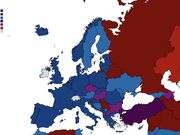
The European Theatre of WW3. Dark-Blue: NATO Allies, Blue: Allies, Dark-Red/Red: Revisionist Powers, Dark-Purple: Nations switching sides, Light-purple: Nations playing both sides
Both Russian and Baltic forces were mobilized at the closest distance possible between each other, leading the armies to meet almost face to face. At the same time, large numbers of Russian troops entered Belarus and started large scale military drills, similar in scale to the the Russian „Zapad-2021“ wargames of September 2021. Meanwhile throughout the Baltics, ethnic Russians, who claimed to be discriminated by their governments engaged in massive anti-NATO protests. These protests were tried to be disrupted by the government, leading to clashes between security forces and Russian protesters. Russia exploited these protests, which were encouraged through Russian disinformation campaigns, and said these were fascist acts against ethnic Russians, similar to how it justified its invasion of Ukraine in February 2022. Russia accused the Baltics and the West overall to oppress Russians within their territory, which according to the Russian government would force Russia to once again intervene and "protect" its fellow citizens. Due to the massive tension between these forces, a series of border incidents occurred, for which both sides were blaming each other.
Estonian and Latvian troops accused their Russian counterparts of cutting through and demolish border fences along the frontier, leading to warning shots to be fired. Russian troops accused the Baltic forces on the other hand of opening fire without warning across the border, while allegedly throwing rocks and tear gas grenades. Reports emerged about Russian forces attempting to cross into Estonia and Latvia without military insignia, similar to how the Crimea invasion occurred in 2014, which was immediately rejected by the Russian government, which called these allegations deliberate fake news campaigns. Despite Russian claims of innocence, troops of Estonia and Latvia presented several Russian nationals as prisoners, accusing them of seeping into Baltic territory the same way Russian troops did during Russia's hybrid warfare campaign in Ukraine after the Euro-Maidan in 2014, prompting an aggressive reaction of the Putin administration. The Kremlin accused the Baltic nations again of oppressing Russians and taking innocent Russian nationals as prisoners for propaganda reasons. At the same time, more and more shootings were reported between Baltic and Russian troops, while simultaneously, the anti-western protests of ethnic Russians became more violent, with even the first people being killed in these riots.
These incidents were used by the Russian leadership to justify a full scale invasion of the Baltics, similar to how the regime launched its war against Ukraine, leading Russian troops to cross into Estonia and Latvia, while missile and air attacks were reported all over said countries. The first objectives of these invasions were the „neutralization“ of hostile forces along the border, while allegedly „protecting and liberating“ Russians inside Baltic territory. Russian troops engaged in heavy combat with the Baltic defenders, who were facing retreat soon after the invasion began. It became apparent that Russia planed to overrunning the Baltics, in order to cut them off from NATO reinforcements, as a way of neutralizing the perceived threat NATO posed to Russia. The Kremlin thought that a quick campaign against the Baltics, before the consolidation of NATO forces in the west, with a following occupation, would lead NATO to accept the Baltics being in Russia's sphere of influence again, in order to avoid a larger conflict by attempting to retake them. When the first line of Baltic defense was pushed back, NATO forces stationed in the Baltics assisted their allies in fighting back against the Russian invaders, leading the British-led battalion in Estonia and the Canadian-led battalion in Latvia to engage in the first fights against the Russians. Belarus, under dictator Lukashenko, meanwhile reluctantly joined Russia as a CSTO member, in order to retain its independence and avoid being annexed itself. Since Lukashenko only remained in power after the 2020 uprising due to Russian intervention, he lacked any leverage to deny Russia its demands, making him effectively depended on Russian goodwill. After being pushed into the war by Russia, Belarus mobilized its troops along its entire border with the Baltics, Poland and Ukraine, while granting Russia not only free access to its territory, but also its own military forces. Russia used Belarus to encircle and invade Lithuania, were it was met with heavy resistance of the already alerted and mobilized Lithuanian army. During the invasion of Lithuania, Russian troops also engaged in combat with the German-led battalion stationed there.
Belarus also allowed Russian troops to enter its territory so it could close the Suwalki gap between Poland, Lithuania and the Russian exclave of Kaliningrad, and cut off the Baltics from possible NATO reinforcements. Poland declared its support for the Baltics, and started to shell both Kaliningrad and the Belarusian border, leading Belarus to declare war on Poland. Meanwhile, Russian troops also invaded Norway in order to protect the Northern Fleet base in Murmansk, while they also went into Finland. Russia justified these moves by declaring it did not expected Finland to remain completely neutral, leading to Finnish forces to launch long range cruise missiles to strike St. Petersburg as an symbolic act of retaliation. And despite the majority of the missiles being either shot down or missing their targets, the resulting damage was enough to cause panic in the city, since this was the first time that St. Petersburg was attacked since WW2. Russian airborne units were dropped off all over the Peninsula, in order to cut off potential reinforcement routes to help the Finnish. Polish troops desperately tried to prevent the Suwalki gap from being closed, but they were pushed back, due to Russian missile and air strikes. The attack against Poland forced NATO to finally invoke its Article 5, leading Germany and other members to prepare the rapid reaction force they were obligated to send in. Meanwhile Canadian troops stationed in the Baltics were almost completely destroyed, leading Canada to declare war on Russia. Both Canada and America declared their support for Europe, and prepared to send in more troops, although the US planned to send only the absolute minimum of manpower into Europe, because they wanted to focus on China at the now called Eastern Front.
Before allied European troops could be transported to Poland, Russia conducted a so called "shock campaign" against Europe. They executed a series of air and missile strikes, hitting military, infrastructural and even political targets not only in Poland, but also Germany, Belgium, the Netherlands and Sweden. Among those targets were important NATO ports, airfields, roads, bases, command headquarters, as well as the capitals of Berlin, Stockholm, Brussels and Amsterdam. The nation which was hit the most by this campaign, which was later nicknamed „The Long Night“, as a pop-culture reference to the popular TV show Games of Thrones, was Germany, because it harbored many important NATO and US bases, while being a very important crossroad for arriving allied reinforcements on their way to Poland. Among the German targets being hit were the US Army Europe Base in Wiesbaden, the American air force headquarter in Europe of Ramstein, the NATO airbase Geilenkirchen, the NATO command of Ulm, as well as the Landstuhl Regional Medical Center. Other targets hit were the EUCOM headquarter in Stuttgart, the ports of Antwerp, Kiel and La Rochelle, as well as Bucharest and missile defense sites in Romania.
This attack was supposed to scare every nation that would want to join the allies from doing so, and even if they do nonetheless, the strike would have destroyed important NATO infrastructure, slowing down the enemies approach. This attack, especially against the neutral nations, created a wave of shock and outrage throughout Europe, due to more than 2000 Europeans and Americans being killed in the process. Germany, which originally did not plan to actively engage besides the obligatory effort, was therefore forced to declare war against Russia, and so did Belgium, Sweden and the Netherlands as well. France and the UK condemned the attack, and declared their total support for their allies, leading them to fully mobilize their armies. Montenegro and Croatia also declared war on Russia, and after days of hesitation due to their pro-Russian right-wing governments, Italy and Greece joined as well, since the threat of their NATO bases becoming Russian targets as well was too evident. Spain and Portugal also joined in soon after, as well as Denmark following the Russian hostilities against Scandinavia. Slovakia and Slovenia also declared their support for their NATO allies, but remained reluctant to issue an official declaration of war against Russia or other Revisionist Powers at this point. While traditionally pro-Russian state Bulgaria, as well as the newest NATO member North Macedonia still issued their neutrality and agreed only to support their allies in logistics, Hungary under the authoritarian rule of Viktor Orbán and the Czech Republic under pro-Russian president Milos Zeman agreed on minor symbolic military assistance to their allies, leading Hungarian troops to be stationed in Warsaw to demonstrate support for Poland, while Czech soldiers were mobilized to guard the Czech border to Poland, as well as supporting minor operations at the southern part of the Polish front. The full engagement of NATO led Russia and China to once again pressure the members of the SCO and CSTO to join their cause, that is why Uzbekistan, Kyrgyzstan, Tajikistan, Kazakhstan and Armenia reluctantly declared war on the US and its allies. Pakistan also issued support for the anti-western alliance that was now dubbed the Revisionist Powers by America, leading India to be the the only SCO member to remain neutral. Mongolia, wedged between both Russia and China, also declared war on the United States to the surprise of many political experts, in order to prevent from being annexed by either Power. Meanwhile, the European allies mobilized their armies to fight against Russia and Belarus in Poland and Scandinavia.
The US army's 173 airborne brigade combat team in Italy, as well as the 2nd cavalry regiment in Germany then rushed to the fight in Poland, although their communication was severely jammed by Russian electronic warfare units, forcing the Americans and their allies to rely on outdated high frequency radio devices. Russia also tried to slow down the British supply line further by destroying the Eurotunnel with a submarine attack, leading to hundreds of civilian casualties. The NATO forces that were already arriving and fighting in Poland meanwhile lost over 60,000 men and women, leading to casualty rates similar to WW1. Polish troops were determined to hold as much ground as possible, therefore refusing to fall back to the main defense line of NATO. The American forces in Poland on the other hand were set back from the first lines of defense as some form of counterattacking force. Due to Russian pressure though, the Americans had to disperse all its divisions to assist its wavering allies. This led to the so called Third Battle of Masurian Lakes/Tannenberg, during which the NATO commander employed the 10th Mountain division to help the poles. Further south, the 1st Calvary and the 1st Armored Divisions started a counterattack, leading to immense casualties beyond allied expectations.
In the Baltics, Russian troops reached the outskirts of the Baltic capitals of Tallinn, Riga and Vilnius in just about 60 hours. The last Baltic army resistance, supported by the remnants of the NATO forces that were stationed in the Baltics before the war as a deterrent, entrenched itself in urban territory as a last attempt to hold the line. In the rest of the occupied Baltic territory, the population followed a strategy of "total defense", meaning that they formed smaller units of civil resistance, that inflicted damage on the invading enemies. Many ethnic Russians on the other hand welcomed the invaders as "liberators" since Russia portrayed the Baltic resistance as anti-Russian and fascist hostilities, leading them, alongside other pro-Russian forces, to sabotage the Baltic resistance. Even though the total defense somewhat slowed down the Russian approach, this strategy of civil resistance led to heavy civilian casualties, since Russia actively targeted civilian areas out of anti-resistance warfare, which was used to justify heavy attacks without regard for civilian life. Overall, the Allies suffered horrendous casualties in a time-span of just 72 hours, losing about 50% of their present forces along the now called Western Front. Ukraine also concentrated its troops even more around the frontlines of the Donbass as well as the southern theatre along the coastal region and in the west at the border with the pro-Russian Transnistria in Moldova, in expectation of new Russian offensives.
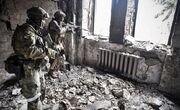
Russian troops engaging in urban warfare
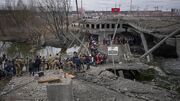
Civilians seeking shelter under destroyed bridges.

American tanks in Eastern Europe.
Following a series of fresh assaults on all fronts, which resulted in heavier Ukrainian losses than before, most of eastern Ukraine was completely cut off from supplies from the defending forces, while Russia began to break through in multiple sectors of the Donbass and Eastern Ukrainian Front. Russia still received support from the Donbass rebels of the self proclaimed republics of Luhansk and Donetsk, who fought on Russian behalf against Ukrainian forces for years, while a new full scale invasion of nothern Ukraine was launched with the help of Belorussian troops, forcing president Volodymyr Zelensky to retreat his troops back into central Ukraine, while also facing Belarusian attacks in the northwest. Additionally, Serbian volunteers and more Syrian mercenaries were trafficked into Ukraine to assist in the Russian war effort, while Russian troops and local forces in Transnistria engaged in skirmishes with the Ukrainian army along the border. While Russian troops were performing brutal attacks in Mariupol against what they described as „partisan fighters“, revisionist forces entered Kharkiv, resulting in the Ukrainian resistance in central Ukraine strengthening its defenses by using the river Dnieper as a natural barricade, since the flat terrain of Ukraine made it almost impossible for the defenders to hold up against enlarged Russian armored formations. Russian bombers then targeted multiple of the many dams of the Dnieper, in order to reduce the reservoirs of water in preparation of crossing the river on their way towards Dnipro and the Ukrainian capital of Kiev, while also new battles erupt in and around Zaporozhye, resulting in damage of the largest European nuclear plant there. The result of the demolition of these dams was massive flooding in central and southern Ukraine, that killed thousands of civilians. Ukrainian forces then dug in into the urban territory, leading to weeks of brutal urban trench warfare in multiple Ukrainian cities. Meanwhile in the Caucasus, Georgia joined the allies, and started its own campaign to retake the territories of Abkhazia and South Ossetia, which were occupied by Russia since the Georgia War at the beginning of the 2000s. Armenia concentrated its forces on its border with Georgia, demanding the end of hostilities in the Caucasus mountains in favor of Russia.
In Europe, every attempt to break through to the Baltics failed, leading them to be completely overrun by Russia in just about two weeks of fighting. The Russian National Guard was sent to counter any potential Baltic insurgency, allowing more army units to participate in the ongoing offensives in the west. Russia then focused its movements on the west against Poland, where thousands of French, British, German, Dutch and Belgian troops arrived. In Scandinavia, the Russian advance into Norway was halted at Alta with the help of British, Swedish, Finnish and the newly arrived Canadian troops, forcing the Russians to dig in into mountainous terrain, in order to protect Murmansk. Sweden attempted to relocate troops from Stockholm and Umea to the Finnish cities of Turku and Vaasa, but due to Russian airstrikes, the ports were largely destroyed. The Russian Northern Fleet started to attack the Norwegian island of Svalbard, occupying the island as a base of operation in the process. The aggression in the Arctic waters forced Iceland to declare war against Russia, after a missile hit NATO stations on the Island. Meanwhile Russian and Belarusian troops advanced into Poland, taking Allenstein and Bialystok, while threatening Warsaw.

Lithuanian troops firing shoulder launched missiles
Allied struggles on the Western Front: The Battles for Warsaw, Helsinki and Kiev[]
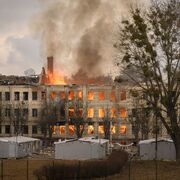
Destroyed military base outside Kiev
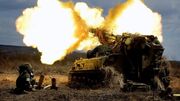
Russian artillery firing against ukrainian targets.
In the Baltic Sea, allied attempts to break through to the Baltics failed, due to Russias Baltic Fleet mining large portions of the sea, while sticking close to the chores. The allied reinforcement from Britain, France, Belgium, the Netherlands, Germany, Montenegro, Spain and Canada finally consolidated itself enough to catch up with their polish co-beligerents, while the US support arrived in the ports of Germany, although lacking severely in manpower needed at the Western Front. Following the Pentagons "Assault Breaker II" strategy, the US deployed 12 B-52H Bombers at the Western Front, armed with Assault Breaker standoff missiles, which were able to release swarms of smaller submunitions with infrared sensors,in order to hunt down and destroy enemy tanks behind the frontline. The US also brought in several JSTARS aircraft to guide the 52s. In the same time, Russia and China forced conscripts from Kyrgystan, Uzbekistan, Tajikistan, Kazachstan and Mongolia to be deployed at the Western Front to support the Revisionist Powers, while Russia ordered the mass mobilization of its population. Revisionist forces were able to take Pulawy, and a few days later Radom, due to constantly harassing allied supply lines, while also using its advantage in tanks and anti-air capabilities , but lost thousands of troops in the process. The Allies started to increase the defenses in and around Warsaw, while taking position to stop the russian approach from Mlawa and Siedlce. Allied air forces were able to install a certain level of air superiority, leading to some of the largest dogfights in history. On the ground, the Allies struggled to bring the russian advance to an End: the UK and France had not only to concentrate on Poland, but also the support for Scandinavia, as well as the Middle East and the Eastern Front, thus limiting their overall capabilities. Germanys army lacked severely in operational equipment, and trained personnel, due to years of heavy mismanagement and underfunding of its military , making it effectivly unable to provide considerable support to the Allies. This, along with lacking support from the US and the limited strength of smaller NATO Partners, lead the Allies to be pushed back to Warsaw. The russian army, and its ally Belarus reached the outskirts of the polish capital, while suffering massive air, missille and artillery strikes, and with its counterattack, the casualty numbers on both sides mounted massively in a very short time, similar to the opening phase of WW1. After the mass evacuation of Warsaw, the Allies dug into the city, hoping they could hold their ground until further reinforcements could be consolidated.

Engaging allied troops
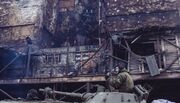
Russian backed separatists advancing into destroyed cities.
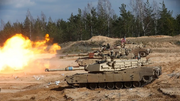
Allied tank fire
In Scandinavia, both the Allies and the russians used the network of lakes in Finnland as natural barricades to strengthen their positions, leading the finnish front to become the next part of the frontline that went static, after Norway. Russians troops were closing in towards Helsinki thanks to both aerial attacks and missile strikes coming from the waters around occupied Estonia , forcing the finnish government to flee to the islands in the Bottnian Strait. The geography of Finland, with its forests and vast network of lakes narrowed the routes of the invading russian armored divisions down a lot in the south, allowing the finnish to hold on to Helsinki for a fairly long time. The usage of portable anti-armor missiles from the scandinavians forced the russian artillery to flatten vast amounts of terrain to allow its armored units to move towards Helsinki as safely as possible, creating massive casualties. Due to continuous bombardment, the civilian population of Helsinki started to seek shelter in the underground bunker systems of the capital, while on the surface, russian troops were besieging Helsinki. In Ukraine, the troops of Salenskyj received one defeat after another, and after weeks of brutal bombing and trench warfare around Kiev, the ukrainian capital falled into the hands of Russia and the Donbass rebels. Pro russian ukrainians sabotaged the war effort of the pro-western army of Salenskyj, leading to civil war like uprisings in the free parts of the nation. Thousands of refugees entered Romania, Moldova, Slovakia and western Poland, hoping to find shelter. The remaining population then saw some form of total mobilization and partisan resistance, due to many ukrainian citizens being armed with black market weapons following the war of 2014. During the first months of the conflict in Ukraine, revisionist troops from Belarus and Russia targeted the ukrainian military positions around the Desaster site of Chernobyl, in order to take out the ukrainian military presence there, as well as securing the location itself. The small military presence and outposts of the imposed safety perimeters soon fell under revisionist control, however, during artillery attacks between ukrainian and belorussian forces, the latter accidentally hit the concrete sarcophagus of reactor 4, which caused the nuclear Desaster in the first place. As a result, the concrete sealing of the reactor was so damaged, that once again critical amounts of radiation were exposed into the environment, leading to the second nuclear catastrophe of Chernobyl. Romanian troops meanwhile entered Ukraine as the first NATO forces in the area, while suffering missile attacks from the direction of the now russian controlled Black Sea, targeting the NATO anti-missile shield there. Many of the missiles were intercepted, but the romanian capital still received some hits. The allied troops then used the swamplands in Ukraine as natural buffers to slow down the revisionist advance , while strengthening their defenses. After a month of non-stop fighting, as well as tens of thousands of casualties in both military personnel and civillian life, Warsaw fell into the hands of the Revisionist Powers.
The allied defeat at Warsaw brought the Allies to the realization that this war won't stop any time soon, that's why the nations of France, the UK, Germany, Belgium, the Netherlands, Norway, Sweden and Finnland ordered the general mobilization of their population, for the first time since WW2. Especially Germany was reluctant to add more manpower to the allied war effort, due to its lack of equipment, trained personnel and the widespread anti-war sentiment of its population, leading Germany to conscript individuals that were unfit for the regular standards of the Bundeswehr. While most of Europe mobilized its citizens for a possibly long and bloody war, the Allies prepared themselves for a big offensive targeting Kaliningrad in the upcoming year. Russia also prepared for further offensives, that's why it deployed its new Armata tank fleet, as well as a Tupolev squadron in Poland against the Allies.Meanwhile, as a symbol of peace and solidarity, artists from all over the world joined together both in person and through video in order to perform a new „Live Aid“ Event, aimed at gathering donations for refugees in Asia, Europe and the Middle East. Singers, bands and songwriters managed to organize multiple simultaneously occurring concerts in London, Paris and Vienna, with another one taking place in New York , making it the largest beneficial concert in human history, which was able to gather around 100 million dollars for humanitarian causes.
2024[]
The Battle for Europes seas[]
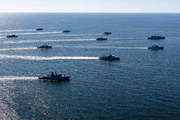
Dispatched allied fleet in European waters.
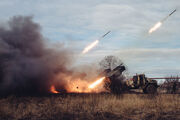
Russian rocket artillery.
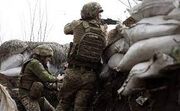
Ukrainian defenders in a trench
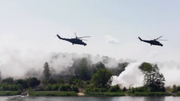
NATO helicopters approaching targets in Eastern Europe.
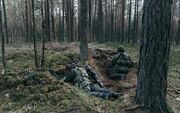
German troops in wooded territory.
While Europe prepared more and more fresh recruits as a result of mass mobilization for the battle against Russia, the war on the european seas was heating up. In the Baltic sea, russian vessels continously layed out sea mines to deny access to the polish and baltic coast for allied ships, while using their Kalibr missiles to disrupt allied supply lines from the sea. The navys of Finnland, Sweden, Poland, Denmark and Germany tried to break through russian naval defenses, but due to continious submarine attacks, air raids from the occupied Baltic coastline and anti-ship missile attacks, said navys suffered heavy losses, without reaching the polish coast. The danish navy also patrolled the entrance of the Baltic Sea, and its own shores, while remaining far enough from the open sea to avoid direct clashes with Russias fleet.Since the allied fleets dwarfed Russias Baltic Fleet, russian vessels stayed close to the coastline and the Baltic Sea entrance close to the danish defense lines to play more defensivly, supporting the Russian airforce by sea. Russian Tupolev bombers in the nothern Atlantic were able to perform several incursions into the north sea, using long distance stand off missiles to hit allied ships that tried to sail further north. A few american surface vessels and submarines were also sent into the Baltic Sea, in order to give additional support to allied forces in the air, sea and on land. The US navy also conducted several missile strikes against russian positions around Kaliningrad and the polish-baltic coastline, while using its submarines alongside polish naval aircraft to destroy the Nordstream II pipeline under the Baltic Sea. This attack wasn’t coordinated with the most of the remaining Allies, and despite claims of the Biden and Duda administrations that this was targeted against Russia, the financial losses and resulting shortages of natural gas mostly affected Germany, leading to speculation that this was the actual intention of the operation. Allied vessels then patroled the UK-Iceland-Greenland gap, in order to prevent any russian attempt to sail further into the atlantic. While the allied navy secured said gap, the fleets of Britain, France, Norway, Belgium, the Netherlands and the US then tried to threaten the base of russias Nothern Fleet in Murmansk, while also targeting the russian coastline. The result was the Battle of the Barent sea, which became one of the largest naval battles of the entire war. The russian Nothern Fleet stayed defensivly, in order to protect the russian coast, inflicting damage to the allied fleet through its attack submarines. Allied ships also came under attack by russian aircraft and anti-ship missiles from the direction of Murmansk, and even though the allied navy slightly outnumbered the russian fleet, the Allies suffered heavy casualties. After losing many ships and aircraft against the russians due to submarine, air, and missile strikes, the allied attack was called off. In the Baltic sea, russian airborne assault troops were landed on the swedish island of Gotland and the Aland islands in the Gulf of Finland, taking those in a rather short period of time. Russia used the time it bought by mining the sea to fortify the swedish island of Gotland, turning it into another base of operation from which it can threaten allied supply lines with additional Iskander missile attacks. In Poland, the Allies tried desperately to slow down the russian approach, in order to get enough time to fully consolidate its mobilized troops. US bombers and allied fighter aircraft managed to establish some form of air superiority, using their vast missile arsenal to hit russian supply lines within conquered territory. Further incursions into russian territory resulted in desaster though, due to Russias S-300 and S-400 anti-air defenses, which were able to hit the enemy from within russias borders. After the fall of Warsaw, Russia started to dug into the city, using it as some kind of fortress against allied approaches, while revisionist troops pushed towards Bromberg and Danzig. Polish troops on the Hel peninsula tried to slow down the russian approach from Kaliningrad by using artillery and guided anti-tank missiles, but they became trapped by russian attacks from the sea, and air and missile attacks from the Kaliningrad exclave, leading them to be almost completly cut off from the mainland.
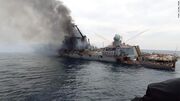
A russian flagship being critically hit.
In Ukraine, the fresh reinforcements in form of the romanian army did not managed to stop the revisionist advance to the west, but were able to prevent deeper incursions from the Revisionist Powers in the North around Lutsk with the support of the Black Sea Fleet, Russia managed to take the coastal town of Odessa, closing in to the ukrainian-moldovia/transnistrian border. Protests of the muslim crimean tartarians against the continous influx of russian forces into the Peninsula, which were seen as an opressing force by many tartarians, where brought to an violent end by the occupying troops. Russia accused the West of encouraging the tartarian protests, which also lead to some minor acts of sabotage against the russian military. As a result, russian troops in Crimea started to use military force against the protesters, leading to days of civil unrest which culminated in a hundred tartarians being massacred by the russians. Russian troops stationed in the moldovian breakaway region of Transnistria were already mobilized and ready to engage in combat, When their counterparts in ukraine reached the outline of the border. Russian troops in Transnistria then allowed soldier movements from Ukraine into Transnistria, without moldovian permission. The moldovian government then demanded that russian troops from ukraine should leave Transnistria immediatly, in order to prevent Moldova from being entangled in the war. The moldovian demands were ignored and russian troops crossed transnistria to prepare an offensive against Starokozache and Russko-Ivanokova in Ukraine, while also taking position in Ribinitai in Order to encircle allied troops in Ukraine. Russian forces then occupied not only the airport of Tiraspol, but also the trainstation in Tighina, which was already outside Transnistria. The pro-western government of Moldova was under increased pressure to take action, since president Maia Sandu was still reluctant to go to war against Russia. But after russian missiles launched from Transnistria hit allied targets in Ukraine, the counterstrike not only hit the breakaway republic, but also Moldova, leading to a ultimatum towards Russia that any acts of war from russian troops in Transnistria should be halted. It's ignored, leading Moldova to declare war on Russia. In the same time in Poland, revisionist troops where able to take Thorn and Bromberg, while fresh recruits from all over Europe arrived on a daily basis in Poland.
The US in the meantime kept bringing in new ressources for the Allies and the aproximate 70.000 US soldiers in Europe, despite occasional submarine attacks. The american EUCOM took over the role as the main allied command in Europe, while NATOs AIRCOM, LANDCOM and MARCOM became the base commands for allied land, air and sea operations overall. The majority of russian submarine attacks remained unsuccessful, due to allied naval superiority and the vast number of enemy vessels to hit, while allied guarding ships prevented larger russian breakthroughs through the UK-Iceland-Greenland gap. Among the US weapons delivered to Europe where large numbers of HIMARS and other rocket launcher systems, aimed for hitting russian targets by long range artillery bombardment. The US also brought in several anti-air and missile defense sytems, just like Patriot and THAAD batteries. Meanwhile, the Allies managed to gather and consolidate enough forces to send more reinforcements along the entire Western Front: Troops from France, the UK, Germany, the US, Canada, Belgium, the Netherlands , Luxembourg and Montenegro took position in Poland, while reinforcements from Italy, Spain, Portugal, Greece and Romania , with french and german support, went to the last free areas of Ukraine. Slovakia, which feared the war will reach its borders as well, also sent troops to the crosssection between the polish and ukrainian part of the front. After weeks of fierce fighting, Moldova was overrunned by the Revisionist Powers, forcing the moldovian government, as well as the remaining moldovian troops to Romania, while russian troops managed to conquer the Odessa Oblast.
Onslaught in the Caucasus[]
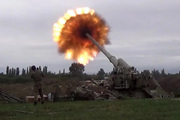
Shelling between azeri and armenian forces.
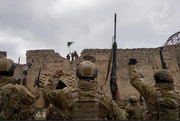
Azeri troops cheering over their conquest.
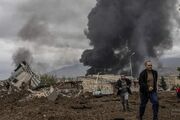
Armenian civilians fleeing bombs in Stepanakert.
While both Europe and Asia continued to plunge deeper into chaos and destruction, the Caucasus, as a crosssection between those continents, also saw increased actions of war. While Georgia engaged in combat against russian backed forces in the self-proclaimed republics of South Ossetia and Abkhazia, both Armenia and Azerbaijan once again went to war against each other. Tensions remained high between the two nations since the reinflamation of hostilities in September 2020 and afterwards, leaving several regions of the disputed territory of Nagorno Karabakh again under azeri control. Despite having a numerical superiority against Armenia, the positions of troops at the beginning of hostilities did not completely favour the azeris. The autonomous azeri region of Nakhchivan was almost completly surrounded by armenian troops, despite azeri advances during the escalation of tensions in 2020 and the implementation of a corridor between Nakchivan and Azerbaijan, while the mountainous terrain of both nations only allowed their armoured formations to act as direct infantry support. The autonomous and disputed region of Nagorno-Karabakh had an army of its own, which was build up and supported by Armenia, allowing armenian troops to enter Nagorno-Karabakh in order to attempt pushing into Azerbaijan, while armenian troops attacked Nakhchivan, using artillery to shell this relatively isolated part of Azerbaijan. Through this intensive bombardement, Armenia managed to take Dyudengya and Shakhbuz, while further north pushing towards Tovuz. The armenian offensive through Nagorno-Karabakh also saw some success due to armenian troops entering Mardakert and Agdam city, threatening Ganja. The armenian lack of fighter jets on the other hand allowed Azerbaijan to establish air supremacy, using israeli Jets and drones for both surveillance and offensive operations. Azerbaijan also used its arsenal of ballistic missiles to stop the armenian push, but due to both sides relying mostly on infantry units entrenched in the mountains and hills , these missile strikes remained rather ineffective. Armenias inventory of anti-air defences lead to increased azeri casualties, although Azerbaijan's advantage in fighter aircraft allowed it to hit several anti-air batteries in counterstrikes. Due to the mountainous terrain, the movements of both sides were heavily slowed down, while azeri jets used turkish standoff missiles to hit armenian targets all over the front, allowing it to increase the pressure on Nagorno-Karabakh. Azerbaijan was able to add a large portion of its reservist pool into the army, which enabled it to retake the occupied territory, while also pushing into the armenian side of Nagorno-Karabakh, taking Stepanakert. Attack helicopters were used by both sides to maneuver smaller concentrations of troops over the hills, while Armenia pushed further into Nakhchivan.
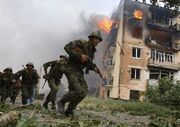
Georgian troops fighting against Russia.

Burning village in Georgia.
Iran supported Armenia by conducting some smaller airstrikes against azeri targets close to its border. Turkey on the other hand used the aggression against Nakhchivan to justify a declaration of war against Armenia. Turkish troops stationed in Nagorno-Karabkh after the war of 2020 joined in on the azeri offensives and provided additional man and firepower. While Turkey launched a full scale invasion and bombing campaign against Armenia, turkish proxy forces, which were comprised mostly of dschihadist mercenaries from Syria and Lybia, also joined the fighting against the armenians, leading to the first reports of war crimes being committed against ethnic armenian civilians in Nagorno-Karabkh and Armenia proper. The aproximately 5000 russian soldiers in the armenian capital of Yerevan where concentrated in the North of Armenia, to open another front against Georgia, while also avoiding confrontation with Turkey over Armenia. The russian peacekeeping forces stationed in Nagorno-Karabakh after the war of 2020 alongside turkish troops were left unharmed by the turks and azeris, and indeed gave way to their joint offensive, effectively abandoning Armenia in the process. In Georgia, pro russian insurgents from the rogue regions of South Ossetia and Abkhazia continued to attack georgian forces gathered around the disputed borders, supported by more than 3000 russian soldiers and russian medium range aircraft and artillery. Georgian troops were able to break through barricades around Ghogethi, and the Tsitelubani and Orchosani region, which were used over the years to take additional georgian territory through creeping annexation. While georgian forces advanced towards Akhatgori and shelled Tskhinavali, the push into Abkhazia was halted by incoming russian soldiers. Russia launched a series of missile attacks against targets all over Georgia, including Zugdidi, Gori, Agara and Karelli, while the russian Black Sea Fleet started to shell georgian positions around Abkhazia. The russian forces at Georgias southern border were able to either take or destroy important infrastructure around Amamlo and Naghvarevi, relieving the pressure on South Ossetia. Turkish troops agreed to stay out of Georgia, while russian forces on the other hand did not interfered with the turkish offensive against Armenia, due to the mutual cooperation agreement Turkey had with the Revisionist Powers.
The Battle of Kaliningrad[]

British troops taking positions.
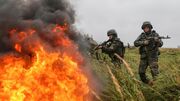
Russian troops during combat close to Kaliningrad
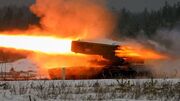
Russia using thermobaric warheads.
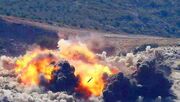
Thermobaric explosions caused by Russian artillery.
With the scandinavian part of the frontline being static, and the Revisionist Powers almost completly taking Ukraine, the Allies were desperate to stop the revisionist advance in Poland. More and more recruits are streaming into the war zone, while allied aircraft and anti-air defences were able to further install supremacy in the sky, despite constant russian harrassassment of allied airfields all over Europe. After the last polish troops from the Hel peninsula have been rescued, and civillians have been brought into the safety of refugee camps along the polish-german border, allied forces started the offensive against the russian stronghol of Kaliningrad, from where a lot of Iskander-missile attacks against central Europe have been conducted. Since the Revisionist Powers focused their strength further south after the fall and fortification of Warsaw, the Allies hoped to neutralize the comperatively small exclave of Russia, in order to stop the revisionist advance. Allied surveillance aircraft and satellites helped them in their local build ups of forces, while smaller offensives all over the polish front occurred as an diversion. Troops from Poland, Germany, France, the UK and to an smaller extend the US and remnants of the lithuanian army started the offensive against Kaliningrad by launching several air and artillery strikes against the exclave, while allied navy assets conducted missile attacks against the russian Baltic Fleet and its base. It was the first time in the entire war that official russian territory became target of actions of war, leading to a fierce counter attack from russian and belorussian forces. Due to the nummerical advan of allied troops, the european offensive did managed to push into the territory of Kaliningrad, while allied air losses mounted rapidly because of russian S-300 and S-400 sytems stationend in the exclave. Russia reinforced Kaliningrad by deplyoying its airborne brigades, including air droppable armoured vehicles. Russias Baltic fleet then launched several Kalibr missile strikes against allied targets on the ground of Kaliningrad, with no regard for their own soldiers there.

Civilians and troops digging trenches along the frontline in Eastern Europe.
The Allies also managed to perform a series of airborne landings due to still being superior in the sky, which lead Russia to use its Iskander inventory with the shortest range possible, creating hundreds of casualties in both allied and russian personnel. Allied air superiority though allowed the attackers to track down several mobile Iskander launchers, leading those platforms to be neutralized. The allied advance soon started to slow down due to increasing russian bombing campaigns against the front line, as well as the inexperience of the new allied recruits. Especially the german forces suffered huge casualties , since Germany conscripted thousands of unfitted recruits with an absolute minimum of training. Russian Spetnaz special forces were deployed in order to interupt allied communications, which was addioned by electronic jamming sytems, just like the Krasukha-4 which was able to blind ISR platforms. In order to stop the allied attacks against Kaliningrad, Russia resorted to the use of rather inhumane conventional weapons.
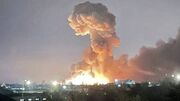
Explosions following the detonation of incendiary ammunition.
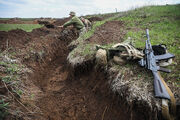
More trenches being dug up in Europe.
Russia decided to deploy its arsenal of TOS-1 MLRS weapons, which fired rockets with fuel-air explosive warheads en masse against allied targets. The warheads spreaded a chemical cloud in the air, that seeped into buildings and every Open space, before being ignited by a secondary explosive. The heat of the long lasting explosions caused lethal burns, the overpressure created lead to the creation of a partial vacuum due to the sudden combustion of air , killing hundreds to thousands of soldiers in grotesque ways. The explosions and resulting fires caused the victims to suffer bone fractures, internal hemorrhaging and suffocation, due to the air that was being sucked out of their lungs. Russia also used Smerch and Uragan MRLS platforms that were using incendiary warheads as well. In order to neutralize russian mobile artillery pieces and anti-air defences, NATO deployed several long range LRA-B bombers at the Western front, which were able to jam even low frequency VHF radars. Germany deployed a huge line of Leopard 2A7 tanks, which saw some minor successes while supported by allied air forces, but since the Bundeswehr only used tungsten ammunition, they were often unable to break through the armour of Russias T-80, T-90 and the superior T-14 Armata tanks. France on the other hand deployed its LeClerc tank brigades that were using autoloader systems capable of shooting up to 12 rounds per Minute. The allied tank offensives were also supported by several attack helicopters, like the american Apache,that were using hellfire missiles , as well as the Eurocopter Tiger armed with Hellfire, PARS 3, HOT 3 anti-tank missiles, as well as Spike missiles. The israeli made 31-pound spike missiles were able to hit targets from a distance of 800m-8 km, piercing through tank armors after the detonation of the tanks own reactive armor, leading to heavy losses on the Revisionist side.
With both sides throwing in the bulk of their most destructive weapon systems, the fighting started to turn into a war of attrition, leading to enormous losses on both sides. With the battlefields being engulfed and devastated by exposions and terrible fire storms, those who survived the carnage would remember the Battle of Kaliningrad simply as "Kalinins Hellgate". After almost a month of brutal fighting, the Allies were forced to call off the attack. At this Point, the Battle of Kaliningrad was the worst Battle of the Western Front so far. The Allies realized that at this rate they wouldn't be able to stop the Revisionist Powers from overrunning Poland, forcing them to change their strategy completly. They started to dig in and fortify the entire Front, leading to a network of trenches, barricades and other fortifications along a line incoherently stretching from the Baltic Sea to Moldova. This was possible due to allied air supremacy and technological advantage, while Russia also fortified multiple of the conquered cities in Poland. The area between the lines became the battlefield of tank, infantry and artillery attacks, leading it to be nicknamed the "New No-Mans Land".
2025[]
The Western Front: War in the Balkans[]
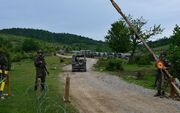
Military border guards at the serbian-kosovarian border.
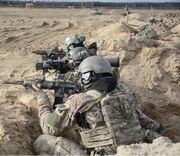
Western troops in their dugouts.
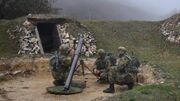
Serbian mortar crew ready to fire.
At the Western Front, movements on both sides slowed down significantly after the bloody battle of Kaliningrad. The Allies kept digging in along the entire front, using razor-wires, trenches, anti-tank mines and severall Patriot and THAAD batteries delivered by the US to fortify their positions. The US also brought in waves of heavy firepower deliveries like M 134 Miniguns and Browning M2.50 Caliber heavy machine guns, that were used as stationary weapons to further prevent any more russian advances towards the west. All allied nations of Europe carried in their biggest artillery pieces, causing unprecedented destruction in the so called "No mans land", the battlefields between the fortifications and positions of both sides. The Allies were able to dig in due to their air supremacy, yet russian S-400 anti-air systems kept causing heavy casualties for the allied airforce, preventing any deeper incursions into occupied territories. Russia was also able to forsee the attack patterns of allied aircraft, especially the NATO F-35-Jets, because of the data it received through turkish S-400 deliveries, that were connected to NATO software by Turkey in 2019 and afterwards . In the North, Russia was still forced to take the defense in the norwegian territory around Murmansk, using mountainous terrain to fortify as well, while preventing allied advances towards its Nothern Fleet base by using cruise and standoff missiles, accompanied by shelling from the Barent Sea. In Finland, allied troops of Sweden, Norway, Finland, the UK and Canada managed to push the revisionist offensive into Lappland back around Inari, forcing Russia to increase its defenses at the nothern russo-finnish border. With the war raging from the Barent Sea to the Black Sea, tensions also started to rise in the Balkans as well. Since most balkan NATO-members were at least officially at war with the Revisionist Powers, and Serbia gravitating towards Russia, Kosovo felt right in its ambitions to build up its own army, in order to protect itself in the case that war breaks out in the Balkans too, especially since nations like Albania and Montenegro could've become targets of russian attacks. While Kosovo continued its efforts to have its own army as already declared and started in 2018, Albania supported this ambition, and offered to help Kosovo improving its relatively young armed forces.
Despite massive serbian protest, albanian soldiers entered Kosovo and started to train its people, while also bringing in weapons and ammunitions. Serbia, which still held a grudge against NATO for its bombing campaign during the Kosovo and Bosnia wars, demanded the albanian forces to leave Kosovo immediately, accusing Albania to pursuit a "Greater Albania" doctrine in Kosovo. Ethnic serbs in the North of Kosovo started to rally together and protest against the albanian military presence and the kosovian build up of forces. The heavy armed Kosovo police force took action against the protesters, and arrested dozens of serbs, leading Serbia to fully alert its armed forces and gather it along the nothern border of Kosovo. Serbian troops engaged in several border clashes with NATO peacekeeping forces stationed in Kosovo since the early 2000s, and as soon as the actions against ethnic serbian rallies lead to the first victims being killed in fights with the police and albanian forces, Serbia declared war on Kosovo and Albania, officially joining the Revisionist Powers in favor of Russia.
The Western Front: Battle for No Mans Land[]
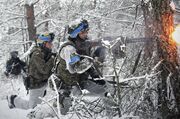
Polish soldiers fighting during winter conditions.
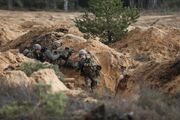
NATO troops charging trenches.
With the year nearing its end, both sides at the Western Front remained in a stalemate. Since winter was setting in, larger movements of heavy equipment became incresingly difficult, leading russian logistics to come close to the brink of collapse, due to Russias forces being overstreched from the Barent Sea all the way to the Black Sea. In the north, the Allies of Scandinavia, Britain and Canada tried to compensate for the deadlock by engaging in guerilla warfare against the russians. Similar to german shocktrooper tactics during WW1, and finish anti-soviet warfare during WW2, norwegian, swedish and finish troops used the remaining forests of nothern Scandinavia as cover in order to perform surprise raids against pockets of russian defences.The allied attack-forces were using new kinds of weapon sights, which combined thermal imaging and image intensifier sights for precision attacks. Since the russian troops where thinned out due to the large front Russia had to cover, this kind of guerilla warfare proved to be very effective against russian attempts to break the stalemate. Russia tried on the other hand to compensate for allied raids by executing Iskander missile strikes against the North Cape, which saw increased fortification as well. More missile strikes hit targets around Hammerfest, Alta and Kautokeino, further disrupting allied supply lines from Norway into Finland. The allied defenders were able to remain somewhat mobile though, using ski-mobiles, Viking armored ATVs, unarmored BV-206s and regular snowmobiles, which allowed the Allies to move in pace with their convois and attacking brigades. In order to protect the allied lines in Scandinavia, the Allies deployed multiple NASAMS air defence sytems, which were using american MPQ-64 Sentinel 3D radars to detect both russian aircraft and missiles, like the Buk-missile. Further south, both the Allies and the Revisionist Powers remained in a brutal fight for the so called "New No Mans Land" in Poland, Ukraine and the romanian-moldavian border. While the main front lines remained static, the killing fields between the trenches, barricades and other fortifications saw fierce tank and infantry battles, supported by heavy artillery fire and air-, as well as missile strikes.
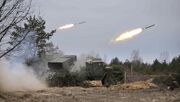
Belorussian artillery in action.
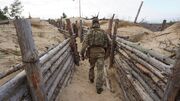
Ukrainian soldier in a trench.
Both sides created heavy guarded openings in their lines, to allow their tanks, mobile artillery pieces and their infantry to march towards the battlefield, while the defences were continously improved with anti-air defences and heavy firepower. The Allies lacked in the latter though, and were usually outgunned by the russians, due to the atrophy of allied artillery units during the years of the „War on Terror“. This lead among others the UK to use cluster missile munitions, to compensate for their lack of heavy firepower. While the Allies also counted on american made miniguns and Browing heavy machine guns, Russia deployed its PKM heavy machine guns, some of which were equipped with ammunition-feeding backpacks, called Scorpios, in order to use a portion of the guns as mobile weapons as well. Since boths sides dug in to hold their gains as long as possible, Russia had to bring in its bigger artillery pieces as well, in order to destroy allied fortified positions. Hundreds of russian 2C4 Tulip self-propelled 240 mm mortars were modernized and brought into service at the Western Front, creating worries of potential use of nuclear weaponery, since the 2C4 had a nuclear mission in the past during the First Cold War. Russia also deployed the TOS-1A Buratino, a thermobaric missile launcher dedicated to destroy heavyly fortified enemy positions through emitting flammable gas clouds that ignite the surrounding air. These weapons proved to be incredibly devastating on the battlefield, but due to their short range, they were suceptible to anti-Tank weaponry and allied counterfire. The russian lead revisionist forces knew that at this rate, a complete occupation of Poland and Finland would be impossible, leading Putin to change the focus of the european campaigns.
Instead of neutralizing NATO forces by occupying as much territory as possible, he wanted to force the Allies to reevaluate the effort the counteroffensives would take, meaning that the Revisionist Powers at the Western Front now followed a strategy of attrition. They thought if they can hold on their gains, while inflicting heavy damage and casualties on the Allies, they would be able to grind the enemies forces down. Russian and bellorussian armored units also utilized a strategy nicknamed „tank-carrousels“, where tanks and self-propelled artillery pieces shell enemy positions, while being in continuous movement between two specialized trenches, in order to avoid enemy counter-fire. Fighting intensified between both sides around Lodz, russian occupied Lublin, and the crosssection between the polish and the ukrainian sector, close to the slovakian border. A russian and bellorussian offensive geared towards Rzesów and Prömsel was slowed down by allied F-16 Fighting Falcon airstrikes, while german PzH 2000 self-propelled howitzers enabled the Allies to counteract the revisionist attacks through Time on Target barrages.
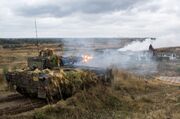
German tank fire close to urban territory.
At the same time, slovakian troops increased their reinforcements for the crosssection, supporting ukrainian, french, german, italian, greek, spanish, portuguese and romanian troops around Stryy, Ivano-Frankivs'k, as well as Chernovtsy. The russians, supported by their allies from Belarus and forced conscripts from the central asian republics, tried to prevent the allied attempt to break through the crosssection, by starting attack waves of Su-27 flanker family aircraft, aiming at diminishing allied air superiority. Those air raids were supported on the other hand by russian made S-400 surface to air missiles, leading to heavy losses for the Allies in the skies over Ukraine and southeastern Poland. The combination of flanker airstrikes, Iskander and S-400 missiles lead to allied troops losing air cover in the crosssection, which allowed the Revisionist Powers to improve their defences in Ukraine and Moldova. Russian movements in southwestern Ukraine remained in a halt though, since neither side was able to break through the enemies defences at the border of the now frozen swamplands of the Danube Delta. Revisionist artillery in Moldova, supported by transnistrian militias and the russian airforce started to shell Galati, Braila and Tulcea, in order to disrupt allied supply lines at the Black Sea coast. The russian Black Sea fleet played rather defensively, staying close to the ukrainian coastline around Crimea, while conducting several missile attacks against romanian targets. In the Balkans, the conflict between Serbia, Kosovo and Albania kept on escalating as well. With the serbian army entering the north of Kosovo, Albania felt fully justified to fully mobilize its army, while sending it into Kosovo to fight against the serbs. Serbian artillery and airstrikes managed to disperse the resistance in a way, that allowed the army to threaten Pristina while also slowing the albanian reinforcements down.
The ongoing war between Serbia and Albania inflamed tensions in Bosnia and Herzegowina anew, leading to massive pro-serbian protests in the serbian-dominated Republika Srpska. The new Balkan war lead the people of Republika Srpska to feel justified in their attempts to form an auxiliary and militarised force, while stressing that the dissolution of Bosnia is due. Bosnia, which was already officially at war with Russia, although staying inactive, felt that these protests and the following violent clashes against bosnian security forces were supported by both Serbia and Russia, and after intelligence reports became public that Republika Srpska talked with Serbia about a possible serbian presence on bosnian territory, Bosnia and Herzegowina declared war on Serbia. With fellow NATO member Albania fighting against a revisionist partner, both Montenegro and Croatia decided to declare war on Serbia, while sending their first expeditionary forces towards their respective borders with Serbia. At the same time, the Allies in Europe came together and initiated a wide series of joint programs for the development of new weapons, aircraft, tanks and other systems, in order to deal with this kind of warfare against the Revisionist Powers.
2026[]
The Western Front: Europes fight for Unity[]
At the Western Front, both sides remained largely in a stalemate. The thousands of casualties, and the lack of of any significant gains lead to growing opposition against the war overall. Europes capitals were haunted by increasing numbers of anti-war protests, some of which became noticeably critical against NATO and the american war effort, despite only a relatively small american presence in Europe. Passive NATO member Hungary under Right-Wing leader Viktor Orban offered to mediate between Russia and the european Allies, as some form of diplomatic effort. Italys Lega party also offered to send a delegation to Moscow, in order to mediate potential peace offers. In the same time, revisionist forces struggled to man the entire frontline because of the length of the battlefield. Logistics proved to be a fragile area for the russians, leading to shortages of supplies at various sectors of the front. In order to relieve pressure on its forces, Russia once again resorted to a terror campaign, to break the already wavering will of the Allies. The Revisionists sourrounding Russia fired salvos of Iskander missiles against european targets, mostly of civillian nature,creating chaos and confusion among the european population. Especially allied capitals were heavily hit, while additionally a lot of rail and road infrastructure was destroyed as well, in order to cut off european supply lines. Russia also tried to intimidate the US by putting its newer weapons at display, leading Russia to deploy its young Avantgarde hypersonic missiles against the capitals of France and the UK, which was the first time during WW3 that mainland british and french targets were hit. Russia therefore tried to demonstrate that it was able to penetrate even the defences of other nuclear powers. The hypersonic missile strikes remained very limited though, because Russia didn't want to waste too many Avantgardes for conventional attacks, while also preventing the provocation of a possible nuclear counterattack from the french or british. The hungarian delegation of Orban in the meantime returned from talks with russian officials, but instead of pushing for a peace treaty under european conditions, they publicly advocated for peace in russian favor, calling it a "peace of understanding and common interests".
Right-wing conservative leaders and politicians all over Europe soon adapted this standpoint, leading representatives from Italy, Greece and the already passive NATO members of Bulgaria, the Czech Republic, North Macedonia and Hungary to advocate for peace under the current conditions from Russia. They justified this move by declaring that the war was largely the fault of China and the US, and that Russia simply defended its own legitimate security interests, referring to NATOs eastwards expansion as justification. At the same time, the italians, who became quite sympathetic of the Revisionist Powers in the past because of their support during the Covid-19 pandemic, stopped fighting and remained only defensive in their actions. Other political parties in countries like France and Germany also joined this chorus, meaning that representatives from the french Rassemblement National and the german AfD party proclaimed that peace with Russia would be vital for Europes survival, while blaiming the war on globalists and liberalism.
While right-wing fractions all over Europe received positive feedback from their followers, there were also massive backlashes because of this. New protests emerged alongside the already existing pacifist demonstrations,that critized the Russia-sympathizers, leading to additional chaos and civil unrest on the continent. The allied leadership in Europe also massively critized the voices calling for peace in russian favor, leading to heated political discussions, changes of personnel and even investigations. Some of these investigations, that were described by their targets as "conspiracys" against peace, found evidence of collusion between Russia and right-wing politicians from various nations. One of these investigations lead to the revelation after the war, that Viktor Orban and his associates received offers during their meetings in Moscow of potentially getting ethnic hungarian territory in Ukraine and Romania, in exchange for pro-russian diplomacy and neutrality in the conflict. These political squabbles lead to disunity amongst the Allies, and therefore a slowdown of their overall war effort at the Western Front. At the same Time, a series of terror attacks in Ireland and Nothern Ireland occured, all of which were claimed by the so called "New IRA", which already conducted terror attacks on the irish island in the years before the Brexit of 2020/2021. Originally, the New IRA was mostly insignificant in Nothern Ireland, but british security agencies noticed increased russian efforts to support and encourage these IRA dissidents, in order to drag the attention of the UK away from the battlefield.
Multiple car bombs were detonated in front of british security targets, like police stations, and new military sites that were opened because of the world war. Bomb attacks were also conducted against targets in Great Britain, and even though the New IRA took responsibility for these attacks, the british secret service suspected that these attacks were rather committed by russian sleeper agents, in order to inflame conflict with the irish terrorists. Nonetheless, the UK decided to increase its security efforts in Nothern Ireland, leading to the deployment of a token force of a few hundred soldiers in Belfast, as well as a dozen soldiers in Londonderry, where the attacks occurred more frequently. King Charles III, knowing about his low popularity as well as Britain's desire for a fresh leadership during this crisis, stepped down as king in favor of his older son William. This also prevented William from continuing his insisted missions for the Royal Army along the frontlines, while Prince Harry kept serving the british military throughout the war without severe injuries. While the european allies struggled to mantain their unity and focused attention, the war at the Balkan Front was still in movement. Serbia fully invaded the now rogue bosnian territory of Republika Srpska, in support of local ethnic serbs, while also attempting to outflank both Croatia and Montenegro. This lead to the Battle of Sarajevo, where the bosnians lost to the nummerically superior serbs, allowing those to secure their positions in Bosnia and Herzegowina, while also shelling the croatian and montenergian borders respectively.
The first Battle in Pristina also ended in serbian victory, forcing the kosovarians to retreat to a line from Pejë to Gjilan. NATO aircraft launched from Montenegro, Albania and Croatia started to strike targets in Serbia, including Novi Pazar, while Sombor and Apatin were hit by croatian airstrikes. As a response to NATOs bombing campaign, Serbia decided to retaliate by deliberately targeting civilian areas and densely populated with its Sumadija rocket launchers, that were able to hit targets as far away as 175 miles with four-hundred-millimeter projectiles and precision guidance. Therefore, after the initial air-campaign, the Allies launched their invasion of Serbia, which lead the latter mentioned border cities to be taken by croatian and slovenian troops, which were supported by italian reinforcements. Romania also initiated an offensive against Serbia, leading to air-raids not only against the romanian-serbian border, but also Belgrade itself. The romanians received reinforcements from Slovakia, France and to a lower extent the UK, while the pressure on Hungary and Bulgaria to join the Balkan campaign increased. Greece also joined the coalition against Serbia, leading greek troops to join their albanian counterparts in Kosovo despite souring relationships between Greece and Albania. Even though Serbia was under pressure from multiple fronts, it was still able to inflict casualties on the allied airforce, due to its purchase of russian S-400 air defenses. Meanwhile, the Allies at the Western Front saw themselves forced to prepare for the worst, meaning a potential russian breakthrough and advance towards the german border, leading them to extensively fortify the polish-german border as a last line of defense. This heavy defended line was nicknamed as the „Merkel -Line“, meant as a mockery reminiscent of the Hindenburg-, and Siegfried-Lines of the germans during the last world wars. Due to still massive outbreaks of COVID-19 among soldiers on both sides, the Allies started to introduce new military gear to wear for their soldiers, like helmets that included visors that covered the mouth and nose area.
2027[]
Operation "Goliath": Europe strikes back[]
In the weeks and months after the „Bombshell-Leaks“ coming from Washington, the allies of Europe, despite the reluctance of some members, co-signed the „United Forces of Europe Act“, an initiative that centralized the the command at the western front independently from the US, while turning the allied armies into one more or less coordinated force. The Allies decided that they have to attempt a large scale breakthrough, in order to collapse the overstretched russian frontlines. That’s why they started with Operation „Goliath“, a plan which intended to create the biggest coordinated land offensive in history. As preparation, new allied airships were used as High Altitude Platforms (HAP), as which they operated in altitudes close to the stratosphere, where they launched anti-satellite missiles and stratospheric drones. Since those airships were less suspicious than ground launched missiles, their deployment was often ignored or even undetected by russian radar systems, leading to the loss of several surveillance satellites. On the ground, the Allies used a multitude of covert ways to mobilize and position the hundreds of thousands of fresh conscripts, which were readied for service over the last years and months, leading to nighttime movements, the usage of civilian and even decoy vehicles. The coordination of these movements was incredibly difficult, and the pressure on logistics immense, but due to diversion attacks at the finish front, closer to St. Petersburg, as well as the Ukranian front, the Allies were able to distract the russians long enough for them to ready their troops and deploy their new weapons. By using civilian trucks disguised as humanitarian and medical aid, the Allies managed to deploy hundreds of new artillery systems, improved tanks and munitions. This strategy would later on lead the revisionist powers to actively target humanitarian forces, out of fear that they would secretly transport allied weapons. Many of the newly designed aircraft were not operational though, and remained therefore hidden at allied storage facilities. Despite some problems occuring in the coordination and preparation of Operation „Goliath“, the Allies finally decided to launch their offensive after weeks of preparation. At 03.00 am at night, the Allies attacked simultaneously at the entire front, stretching from the Finmark in the North, all the way down to the Black Sea.
The new long range artillery systems, many of which were of primarily german design, shelled the frontline relentlessly, using a wide array of projectiles, ranging from rocket assisted, to smoke and even EMP shells, the latter being designed and provided by the US before the scandal. The artillery bombardment, that was directed with the help of aerostat drones, was also targeted against russian anti-air defences, like the S-400 and S-500, leading to heavy losses for the revisionist powers. Due to many S-400s and 300s being hit by long range artillery fire, the allied air force was finally able to penetrate deeper into enemy airspace, delivering bombs and missiles to the revisionists rear. The simultaneously attack along the entire front, supported by allied naval vessels in the Barent, Baltic and to a smaller degree Black Sea, overwhelmed the russians and their allies, due to their overstretched forces and the additional fronts that pinned down russian troops. Russia, after all these years of fighting, also lacked the resources to provide all fronts with the capacities needed to counter the offensive effectively. Despite incredibly high casualties, the Allies finally broke through multiple sectors at once, forcing the Russians to take a completely defensive stand in Norway, Ukraine and Moldova, while the latter was abandoned by the Russians after a few days, in order to strengthen the defences in Ukraine. Overall, Operation „Goliath“ was seen as the biggest success of the Allies so far, and an embarrassment for the Russian autocrat Putin.
The russians also engaged in fierce fighting in the Odessa Oblast, but due to the numerical superiority of the Allies, as well as the combined effort of air, naval and artillery forces, the pocket of revisionist resistance in the Oblast was soon encircled and cut off from the rest of Ukraine, leading to heavy casualties and the capture of hundreds of russian soldiers. Putin ordered that the main focus of the Russian counter-operations should be put on the polish section of the front, as well as the Baltic coastline and southern Finland, in order to avoid St. Petersburg being threatened. The new european approach partially blindsided the Americans, leading US troops to be exposed to enemy fire, because of lacking communication with their european counterparts. Since american casualties in Europe mounted because of this development, Trump and his immediate associates demanded the offensive to be halted and coordinated under the direction of the US leadership, which was rejected by the reorganized european command. Despite the US stopping some weapon deliveries to Europe because of this, the americans reluctantly followed through with the new approach of the europeans, since the US couldn’t afford Russia to succeed at the Western Front, since Russia would then focus on the Eastern and Nothern Front against the US. Several european nations gained new commanding powers in what was now dubbed the „Alliance of the United Forces“ (AUF), leading the UK to get the main command over the european navy, France getting the main command over the army, while Germany took over sub-commands like the allied tank and submarine forces, as well as many logistical and supervisory commands. The european air-command, and the nuclear deterrence was equally distributed between Britain and France, while Germany also retained a lot of influence in the air command.
Many of the southern european allies, as well as the neutral NATO member Hungary felt left out the distribution of influence, despite Italy and Spain being core members of the reorganized AUF naval and air corps. The new structure still had immense flaws, that often slowed down the european offensive, but the initial gains lifted the spirits of the war torn continent, and energized especially the younger recruits who were firstly drafted during this war. Due to the constant demolition of russian anti-air defences, the successes on the ground were accompanied by firece dogfights in the sky, as well as waves of allied bombardment raids against the revisionist lines. This new situation lead the chinese to dispatch some 2 thousand soldiers to the western front, in order to relieve pressure off their most important ally in the war.
2028[]
The Western Front: The Revisionists in Retreat[]
The Revisionist Powers weren’t facing crisis in 2026 just at the Eastern Front, but also in the west, where the revisionist forces of Russia, Belarus, Serbia and their few reinforcements from China and the central asian republics were confronted by a reorganized and nummerical superior enemy. The new allied european structure of the AUF continued to enable the Allies to coordinate their offensives more effectively and on a larger scale along the entire Western Front, which heavily increased the pressure on Russia, which was still overwhelmed by the allied approach due to overstretched forces, failing logistics and material shortages. Especially the so called crossection between the polish and ukrainian sectors of the front were increasingly difficult for the revisionist to hold, with belorussian territory getting directly hit by allied attacks for the first time since the war broke out.The continuous waves of combined longe range artillery bombardment, mass airstrikes and incoming tank fires forced the revisionists to retreat along the southwestern border of Belarus, creating a wider opening between the polish and ukrainian fronts. Russia decided that its main focus should be Ukraine, the nothern part of the polish Front and southern Finland, in order to avoid russian territory to be threatened by allied air, missile and artillery attacks. This need to disperse its attention lead Russia to lack in enough forces and material to effectively fight back against the Allies in Scandinavia. While russian forces engaged in fierce battles with finish, swedish, norwegian, danish, british and canadian troops along the finish border in Lappland, russian forces in Norway finally retreated back to the russian border, leading the russian Nothern fleet to increase its naval bombardment of the allied coastline, to prevent its base on the Kola Peninsula to get threatened. With such a large Front being attacked simultaneously, Belarus was left to fight along its border against allied troops with a far smaller portion of the resources available for its russian ally, leading the remaining recruits of the central asian republics to be sent almost entirely to the now threatenend belorussian line. This new situation caused uprisings inside Belarus against dictator Lukashenko and his support for the revisionist war effort. Allied troops of Romania, Slovakia, Spain, Italy, Portugal, France and Germany to push deeper into Ukraine, while being supported by ukrainian militia and remnants of the moldovian forces. With these ground gains being in process, the allied leadership of Europe negotiated with other nations at war with Russia for additional support at the Western Front, leading to talks with Australia, New Zealand and Japan about sending troops to Europe. Meanwhile, the belorussian troops of Lukashenko remained under intense pressure from the Allies, forcing the Revisionists to create new lines of fortifications along the southwestern and western border of Belarus, leading them to dig new network of trenches, tank dugouts and anti-tank ditches, in order to prevent the Allies from invading Belarus.
The Revisionist Powers also redeployed several S-300 anti-air batteries to the belorussian sector, to cope with the increasing number of allied air incursions into revisionist airspace. The Allies, despite their initial successes also faced troubles of various kinds, since their offensive often moved faster than they could consolidate their gains sufficiently enough, leading them to slow down their approach more than originally planned. There was also discontent among the allied leadership in Europe, because several allied nations, like the UK, Italy and the Visegrad states still had issues with being integrated into a more unified european military. The british feared to not having enough influence in this conglomerate of european forces, leading to skepticism of the value of such a project. Pro Brexit politicians argued that the Alliance of the United Forces would take sovereignty again from the UK, and would open the door for future exploitation of other european powers, leading to calls for a limitation of commitment to the AUF. Italy felt that it was left out of several decision making processes which was, along with its still present sympathy for the Revisionist Powers, the reason why Italies commitment for the allied war effort remained comparatively lackluster. While the already more reluctant Visegrad nations feared of being even more dominated by the western european powers, the US as the biggest non-european ally voiced a strong rejection of the independent european operations. American leading figures in Europe felt often blindsided by their european counterparts, while president Trump called this development even treasonous, while threatening to pull out all american troops out of Europe.
Only due to the resistance of not only oppositional Democrats, but also many republican and military leaders, as well as a european diplomatic mission, Trump was convinced to not retreat from the Western Front, but relations kept on souring going forward. Despite this diplomatic disunity, and the still immense strain on the allied supply and logistic lines, the Allies were able to exploit their technological and numerical advantage to secure their gains to such a degree, that Russia was forced to retreat on many fronts simultaneously, like eastern Finnland, southern Poland and central Ukraine. Especially Germany, with the highest population in the EU, managed to mobilize enough forces to have a significant presence in Poland and Ukraine, while german reinforcements were also sent to the Balkans. Since the majority of these drafted forces were younger germans in their 20s and early 30s, many experienced a new kind of patriotism which was based on the joined achievements of the european Allies and Germanies accomplishments during the later stages of the war, enabling the re-militarization of Germany even more. In the Balkans, Serbia faced pressure from all fronts. Albanian, bosnian, montenegrin, croatian, italian and greek troops were able to overrun Republica Sprska in Bosnia, forcing the serbians to retreat back into their territory after the Second Battle of Sarajevo.
Serbia also faced an total invasion of its territory, forcing it to dig in in central Serbia, in order to protect Belgrade, leading to increadibly brutal fighting with heavy casualties on all sides. Allied airstrikes and artillery bombardment was now able to reach every corner of Serbia, leading to a steady decline of serbian airpower, anti-air capabilities and supply routes. With the revisionists being in retreat at all european theaters of the war, allied troops in Greece began militarizing the islands close to Turkey, due to increasing turkish provocations. Greece received minor support from the british, germans and french, while Italy, Spain, Portugal and France helped to increase the allied naval presence in the eastern Mediterranean close to Cyprus, as well as the western Aegan Sea, in the case of potential turkish aggression. While greek and bulgarian forces are still clashing with tens of thousands of refugees coming from the turkish border, more and more reports came up about shots being fired at greek security forces from the turkish side of the border. The number of military servicemen among the turkish forces at the border appeared to increase over weeks, while greek media outlets claimed that turkish military crossed the border at multiple points of the Evros river, occupying several of the river islands in the process. Turkish warplanes also conducted more provocative maneuvers, like flying close to densely populated greek islands, although the turkish administration under dictator Erdogan denied any allegations from the west. At the same time, Australia, New Zealand and Japan agreed to send small contingencies to Europe, in order to increase the pressure on Russia.
The Western Front: The Fall of Serbia[]
Indonesia wasn’t the only Front which proved to be a success for the Allies. At the Western Front, the allied advance against Serbia gained more and more traction, with allied forces invading the Balkan state from all directions. Serbian forces were dug in in heavily defended positions around Belgrade, while another defensive circle was held from Valijevo to Smederevo, as well as Šabac over Zemun to Pančevo. The fighting between allied and serbian forces was butal, with some days reaching a death-toll of over 10 thousand casualties on both sides. Serbias rather robust anti-air defences still managed to inflict severe damage to the allied airforce, which kept bombing Belgrade and other serbian strongholds on the entire Balkan Front.Serbia declared that it would never surrender, but realized, that at this rate, the serbian army couldn’t hope of holding the lines indefinitely, especially since the Allies deployed some of their new weapons systems, which were developed during joint european programs against Russia over the last few years. Among those were the newly improved tanks of franco-german design, several german artillery systems, as well as improved fighter and bombing aircraft, which were developed, among others, with the support of the US. Allied artillery kept pounding revisionist strongholds, while Serbias most vital infrastructure was in ruins, which slowed down serbian supply efforts. Due to the allied advance in Ukraine, the russian Black Sea Fleet was forced to retreat back to the waters around Crimea, leaving Serbia with no additional missile support as a consequence. Allied airships were also tested for the first time as potential bombing aircraft, and despite heavy casualties inflicted on the serbian defenders, the Allies stopped this testing due to the lack of accuracy and the vast destruction caused by the heavy payloads, which also hit larger quantities of civilians. The Allies still kept high pressure on Serbia, and made simultaneously diplomatic efforts to get Austria as another european nation to join the Alliance of the United Forces, which was met with skepticism by the austrian government, which preferred to stay neutral as long as possible. At the same time, allied troops in the now occupied Republika Sprka faced sabotage and violent assaults coming from ethnic Serbs fighting the allied advance inside Serbia. Allied patrols became the targets of snipers, mine warfare, and even car-bombs and urban insurgency.
Even outside of Bosnia and Serbia, ethnic serbs kept sympathizing with the serbian war effort, leading to riots and attacks being conducted in nations like Croatia, Albania and Kosovo. Almost simultaneously, islamist terror attacks, which were already reinflamed in the Balkans since Serbia entered the war and reportedly committed several atrocities against muslims in its occupied territories, became more frequent inside Serbia. Those attacks put additional pressure on Serbia, and diverted some of its attention inwards, but still remained mostly symbolic in nature, despite heavy civilian death tolls and infrastructural damage. Food shortages also became an increasingly dire problem for the defending serbians, due to being completely cut off from foreign supplies, leading to some calls for stopping the war before Serbia would totally collapse. Those calls were furiously rejected though, since the serbian military and political establishment viewd defeat at the hands of the Allies, especially through its Balkan enemies as an intolerable humiliation. Because of that, allied offers for a ceasefire were rejected, leading the Allies to intensify their bombing campaign against Sebia. The reason for that was, that the allied military command wanted to defeat Serbia as quickly as possible, in order to free up more forces to use at the polish sector of the Western Front. The Balkan NATO members of Bulgaria and North Macedonia were still reluctant to seek a more active approach to the allied war effort, due to large parts of the political establishment of these nations still being rather pro-russian. But since the pressure to join the AUF grew with every day, as well as ethnic tensions inside North Macedonia and Bulgaria caused by serbian riots and attacks, both nations saw themselves to participate more on the Allies behalf, leading to increased logistical support and more granted access for the Allies by both Bulgaria and North Macedonia.
Bulgaria also fully mobilized its army for the first time during the war, not only because of the escalation in Serbia, but also the growing tensions with former NATO member Turkey, which kept actively sending refugees towards the greek and bulgarian borders as human weapons to put pressure on allied nations. Meanwhile, Serbia was almost completely overrun by the Allies, leaving only Belgrade and its immediate surrounding regions unoccupied. Allied missiles, artillery shells and rockets kept hitting the serbian capital and the defensive lines in the region on a daily basis, leading to more and more breakthroughs by allied forces. Despite heavy resistance and immense casualties inflicted on the Allies, allied troops finally managed to reach the outskirts of Belgrade with massive air support. The Battle of Belgrade that followed after was one of the bloodiest of the entire war, with thousands of allied troops and even tens of thousands of serbian forces falling in just a couple of days. After almost two weeks of fighting, Belgrade fell into the hands of the Allies, leaving Serbia defeated, despite remaining resistance and continued urban insurgency.
Turkey joins the Revisionists: Erdogan vs Europe[]
Mexico wasn‘t the only nation joining the Revisionist Powers in late 2026 due to ongoing conflicts with western countries. Tensions in the Eastern Mediterranean kept escalating, after the forced influx of tens of thousands of refugees coming from Turkey to Greece and Bulgaria, while turkish and greek security forces clashed with each other through the greco-turkish border. Due to the continuously rising tensions with the west following its exclusion from NATO, Turkey intensified its naval presence in the waters around Cyprus and several greek islands, in order to secure turkish maritime claims and natural resources. Reports also came up about turkish vessels bringing military equipment and personnel to the Turkish Cypriot Republic, despite an international weapons embargo still being in place. As a result, greek, french and british warships engaged in various standoffs with turkish vessels, while the turkish airforce conducted mock attacks on allied ships. After coming increasingly close to each other, turkish and western soldiers harassed each other, by using water hoses and shots in the air to disperse the vessels of the opposing side. During these standoffs, several greek ships close to Cyprus and Crete were rammed by turkish vessels, prompting exchanges of fire. Almost immediately after, turkish naval units actively attacked greek and french ships, leading to dozens of allied casualties. The turkish airforce was also deployed, and buzzed several allied planes, while pursuing the greek navy, leading to near-clashes between each sides airforce as well. Turkish dictator Erdogan blamed the recent escalation on Greece and the Allies, and vowed to defend turkish interests with all means necessary. The Allies on the other hand condemned the turkish aggression, and made an ultimatum, which called for a complete retreat of turkish naval forces from officially greek and cypriot waters. Turkey rejected the ultimatum, and declared that it will never give in to allied demands, which it called „fascist and imperialist“ intentions. Instead, turkish soldiers were landed on the small greek island of Kastelorizo, which was the center of the greek-turkish EEZ conflict for years, and planted the turkish flag on the island as a sign of conquest. The ports of Kastelorizo were blocked by the turkish navy, while the few hundred greek residents were put under a curfew. As a result of the escalation, Greece mobilized a large portion of its troops and sent them close to the border, as a show of force. The europeans AUF also intended to increase greek defences in the south, which was why the allied european command deployed several anti-air batteries, anti-ship missiles and artillery pieces to Greece, which were supposed to be deployed on greek islands off the coast of Turkey. When the news broke about allied weaponry arriving in Greece, Turkey saw itself forced to take preemptive action, which lead to turkish troops entering greek territory in several locations of the Evros river, where they occupied river islands and small chunks of greek territory. Turkish troops also assaulted the greek islands of Lesbos, Chios, Samos, Kos, Rhodes and the Northeastern Aegan Islands, where they engaged small contingents of the greek national guard.
The fact that these islands were so numerous and close to Turkey, while being too far away from mainland Greece, meant that the greeks were unable to send enough reinforcements fast enough to its eastern islands, since Turkeys stronger navy and its closer airbases additionally complicated greek movement of troops. Turkey comparatively large amphibious assault fleet enabled it to land its troops much quicker on greek islands, than the greeks could reinforcements, leading on greek island to fall after another. The attack on Greece finally forced NATO and the AUF to officially treat their former ally as an enemy, which lead Greece to declare war on Turkey. On the same day, France, the UK, Egypt, and Saudi Arabia also declared war on Turkey, while a few days later, Israel, the Netherlands, Belgium, Italy, Spain, Croatia, Sweden, Finland, Portugal, Montenegro, Iceland, Luxembourg, and the saudi dominated GCC members also declared war on Turkey under the AKP dictatorship of Erdogan. Germany hesitated to join in on the defence of Greece, due to its large turkish population, which included a majority of Erdogan supporter, since it feared domestic unrest and attacks. But after a few couple of days, Germany also declared war on Turkey, as did Australia and New Zealand, as well as most of the remaining EU.
The US was also reluctant to join, due to Trumps lack of interest of fighting Turkey in support of the europeans, but due to NATOs article 5, and pressure from the american military establishment, the US also declared war on Turkey. After the american declaration of war, Erdogan held a rally in Ankara, where he swore in his followers on a „Holy War“ against all of Turkeys enemies, at the end of which, Turkey would come out as a glorious victor with the blessing of Allah. Turkish troops amassed around the NATO bases in Izmir, Ankara, Gaziantep, Dyabakir and Adana, seizing those assets, while additionally, turkish troops also took the US bases of Mersin, Batman and Kürsehir. Only Incirlik was left untouched and was instead besieged, including the installment of a No-Fly-Zine, in order to prevent the US from moving its nuclear weapons out of Incirlik.
On the same day as the greek declaration of war, turkish troops also launched an invasion of Cyprus. The closeness of Cyprus, just like it was the case with the eastern greek islands in the Aegan Sea, enabled Turkey to send airborne and naval units to Cyprus much faster than the Allies, leaving the greek cypriot forces with almost no allied support. Since the greek cypriots still operated relatively large batteries of heavy artillery and anti-air defences, casualties among the turkish ground and airforces mounted rather quickly. In order to compensate for this, Turkey used turkish cypriot forces as a vanguard, while assembling enough reinforcements to support its earlier deployed airborne units for the full conquest of Cyprus. Greek, french and british naval units present in the waters around Cyprus tried to take on the turkish fleet supporting the invasion of Cyprus, but with a lack of land based air cover, those forces came under attack from turkish planes, attack helicopters, submarines and fast attack boats. The invasion of Cyprus proved to be much slower than expected, due to the fact that the turkish army had to assemble its forces on almost all of its horses, leaving only a fraction of them for the Cypriot campaign. While turkish paratroopers were landed in the cypriot Troodos mountains, where they engaged in heavy mountain warfare with cypriot troops and their few allied reinforcements that were already present before the conflict, greek troops mobilized at the turkish border tried to launch a counterinvasion of East Thrace, using armored mechanized formations to cross the border. The AUF decided to send its „Southern Contingent“ in support of Greece, meaning spanish, portuguese, french and british forces, under italian command were deployed as the first line of defence, while the „Balkan Contingent“ of croatian, montenegrin, romanian and slovenian troops under a joint allied command also sent troops to Greece.
During the Battle of the Maritsa, turkish and greek troops clashed heavily, leading to thousands of casualties in a short period of time. The allied airforce, now including french, british, german, italian, belgian and spanish planes, also conducted their first strikes on turkish soil by attacking the entrances of the Bosporus tunnels as well as the Bosporus bridges in Istanbul, killing hundreds of civilians in the process. Istanbul also became the target of allied strategic bombing, since the Allies tried to destroy as much of the present forces, infrastructure and bases around Istanbul as possible. The closeness of turkish airbases, and the destruction of the Maritsa bridges, lead to a halt of the allied advance at the turkish border, while the Allies, especially the greeks suffered heavy air-casualties. As a result, the turkish army launched a invasion of not only Thrace, but also Bulgaria, which declared war on Turkey the same day. While the Balkan Contingent deployed forces to assist Bulgaria, first battles between turkish and arab forces in the south emerged, during which kurdish militias, who were in negotiations with the Allies for protection and support, joined the fight against Turkey in Syria and Iraq, while PKK sympathizers launched new attacks against the turkish military and police force in southeastern Turkey.
2029[]
The Western Front:The Liberation of the Baltics[]
Despite the opening of a new front against their former ally Turkey, the Allies of Europe and forces from the US and Canada managed to advance further along the Western Front. While suffering heavy casualties, the by now outnumbered, and rather badly supplied revisionist forces of Russia, Belarus and their supportive recruits from the central asian republics and China, were forced into what constituted a full retreat on all fronts. Due to the combined pressure through allied airstrikes, relentless artillery bombardment and missile attacks, the Allies were able to deepen the split between the polish and ukrainian sector of the front, which lead to allied troops breaking through the belorussian lines. Since Russia focused on the defending Kaliningrad, while preventing further breakthroughs in Poland and Ukraine, the russian support for the troops of Lukashenko remained rather lackluster, leaving the belorussians with only a small portion of the revisionist resources. Brest was the first belorussian city to fall into allied hands, while the advancing troops from Poland, France, Germany, the UK, Romania, Ukraine, Slovakia and remnants of the baltic armies to push deeper into Belarus. The war became much more mobile than in the prior years, leading to massive tank battles and infantry clashes. Britain deployed several bataillons of its Challenger 2 tanks, while Germany brought in a modernized version of its Leopard 2 tanks, causing heavy casualties among the defenders. In order to stop the invading forces, Belarus deployed dozens of its Polonez Multiple Launch Rocket system, which was improved through chinese cooperation and was able to fire 300 mm A200 missiles of chinese design. Despite suffering casualties, those missile launchers were too few in numbers, to prevent the Allies from taking Mosyr, Kobryn and even Slonum. The invasion of Belarus also reinflamed massive civil unrest and violent clashes between protesters and the security forces of Lukashenko and Russia. While the belorussian regime started to use deadly force against its own people, Russia faced issues of its own on all fronts. In Ukraine, the continued bombardment of the Allies, and the steadily increasing rate of airstrikes due to Russia’s S-400 and S-300 systems either being destroyed by allied artillery or running out of ammunition, the occupying russians struggled to hold their lines west of the Dnieper river.
Since the Allies enjoyed a nummerical advantage over the russians, Russia refurbished its old soviet era tanks, which were stored in old graveyards for military equipment, in order to compensate its losses on the battlefield. While its T-400 Armata tank still preformed very well against its allied counterparts, the redeployed soviet era tanks, many of which couldn’t be turned operational again, were outweighed and outgunned by many allied tank versions, while the use of israeli made Stinger anti-tank missiles lead to heavy losses. Vladimir Putin contemplated the idea of using the threat of nuclear weapons use against the Allies, in order to prevent any further allied advance. Since this would’ve also increased the risk of allied nuclear strikes against russian territory, which is why Russia decided to retreat East of the Dnieper, in order to use the river as a natural barricade. As a result, the Allies managed to advance all the way towards the other side of the river, while Crimea was effectively cut off from mainland reinforcements. In the North, allied troops from Scandinavia, the UK and Canada managed to force the russians to pull out of Oulun Lääni after the Battle of Kajaani, in order to secure the russian border on the Kola Peninsula. In Norway, allied forces kept pounding the russian lines, increasing the risk of breaking through into russian territory, but since Russia stationed more of its S-400 and its newer S-500 anti-air defences, the allied airforce wasn’t able to penetrate deep into russian territory and instead conducted cruise missile strikes from the rear.
New naval clashes occurred in the Barent Sea, but instead of challenging the Nothern Fleet like in earlier years, the allied navies of Scandinavia, Britain, Canada, the US and Germany after the revitalization of its military, sticked closer to the norwegian coastline and conducted long range missile strikes through british, american and german submarines, targeting Russia’s Nothern Fleet base in Murmansk, leading to heavy damage of Russia’s nothern ports. Further south in Finland, finis, swedish, british, danish and canadian forces started the allied offensive targeted to retake Helsinki and potentially land troops in Estonia. After the Battle of Lahti, allied troops kept closing in to the russian occupiers in Helsinki, leading to heavy tank and artillery warfare. Harsh winter conditions put a severe strain on both sides, but due to Russia’s collapsing supply lines, and lack of resources, the Allies managed to compensate for the resulting disadvantages much faster. After the fall of Espoo, the Second Battle of Helsinki began, leading to heavy fighting on the ground, in the air and on sea. The allied navies of Denmark, Sweden, Poland, Finland and Germany wer able to clear most of the russian sea mines after several weeks of the initial start of the Helsinki campaign, resulting in naval bombardment of russian positions not only in southern Finland, but also he coast of the Baltics and Kaliningrad.
The advances of the allied navies in the Baltic Sea forced the russians to station their Baltic Fleet closer to the shores of Kaliningrad, as well as Finskiy Zaliv in order to protect St. Petersburg. Allied land based missile forces in Sweden and Åaland also conducted long range missile strikes in support of the allied advance towards Helsinki, causing heavy casualties among the russian occupants. Russia also used long range missile attacks of its own, leading to the launch of Iskander and Kalibr missiles against allied strongholds and capitals like Stockholm and Berlin, but those missiles remained too few in numbers to effectively slow down the allied offensive. Both sides suffered heavy casualties, but since the Allies enjoyed an advantage in manpower, the Kreml decided that the defense of Helsinki has become too costly, and therefore ordered its troops to move back closer to the russian border. Since the russian Baltic Fleet had to take priorities earlier on, there were not enough naval forces present to prevent an amphibious and airborne assault of the Allies on Hiiuma and Saarema, leading those estonian islands to become the first pieces of baltic territory to be liberated from russian occupation.
The allied advances in the nordic and baltic sectors of the Western Front also re-encouraged the „total resistance“ of the baltic states, which meant a steady increase in assaults against the russian occupants by estonian, latvian and lithuanian civilians, who formed militias during the war with the support of regular troops and special forces. This caused new atrocities committed against the baltic civilian population, but since the Revisionist Powers had to focus on the frontline, the russians and belorussians lacked the forces needed to strike down the baltic guerilla campaigns effectively. In Poland, the Allies concentrated their offensive on central Poland, in order to drive an opening between the russians and Belarus, so that the Allies can break through the Suwalki gap into baltic territory. In order to achieve their ambitions, the Allies followed a modernized version of the Cold War era doctrine of „AirLand Battle“, which focused on precise coordination between large mechanized ground forces and attack aircraft. Allied long range artillery pieces, including towed heavy howitzers and rocket launchers bombarded russian anti-air defences from a far, in order to allow allied aircraft to penetrate the airspace of the occupants. The Allies used rocket assisted, guided, cluster and even experimental EMP charges of euro-american design to strike russian assets with high precision, while the EMP charges additionally blinded revisionist communication systems.
Allied fighting aircraft like the F-35, the F-16 Fighting Falcon, the B-52 and the newly designed and improved Tornado, Typhoon and Eurofighter jets then conducted airstrikes on enemy assets supporting front line revisionist troops, and bombed supply elements in the rear. The Allies also deployed newly designed aircraft stemming from the initially franco-german FCAS project, while the first exemplaries of a supersonic bomber remained in storage because of a lack of testing. On the ground, allied tanks from Europe, Canada and the US rolled through enemy lines with the support of self-propelled artillery systems, like the german PzH 2000 and its newer version, the PzH 2025, allowing allied infantry to exploit the created openings in the enemy’s defences. This concentrated pressure on the Revisionist Powers allowed the Allies to retake Łódź and Lublin after years of russian and belorussian occupation. Ammunition shortages lead to occasional halt’s of the allied offensive, but since the allied powers of Europe and the US didn’t face blockades like the Revisionist Powers, those shortages were less severe compared to the ones of the chinese and iranian militaries, among others. Due to allied negotiations and agreements, the first expeditionary forces from Australia, New Zealand and Japan arrived in Europe as as a symbolic show of solidarity, while Austria dispatched a first contingency for the Western Front as well, after joining the Allies in the wake of the turkish attack against Europe. The retreating russians from the Western Front followed a modernized version of a past military strategy themselves: „scorched earth“.
In order to harass allied supply lines, as well as destroying infrastructure which could be used by the Allies, Russia conducted large carpet-bombing like campaigns against the allied lines, while destroying large portions of terrain, while also obliterating occupied cities shortly after retreating from those. The resulting devastation slowed down allied movement and lead to massive casualties among both the allied militaries, as well as the polish and ukrainian civillian population inside the occupied territory. Nonetheless, the Allies still enjoyed their regained air superiority, which hindered russian air-operations in allied airspace. After several delays of their operations, the Allies finally managed to launch their counteroffensive to retake Warsaw, leading to almost two months of heavy fighting, leading to another tens of thousands of casualties for both the Allies and Revisionist Powers. Further in the north of Poland, the Allies were able to conquer Danzig due to the combined effort of allied ground, air and naval forces, while shortly after, Allenstein also fell into allied hands despite heavy russian bombardment along the entire front. After the fall of Allenstein, the Allies eyed another attempt to take the russian exclave of Kaliningrad, which served as a vital base of operation for the Revisionist Powers in the beginning of the war, while the First Battle of Kaliningrad, „Kalinins Hellgate“ became one of the bloodiest battles of the war and one of the deadliest in human history. The offensive aimed at neutralizing Kaliningrad as a threat for european security, creat an opening for breaking through to the Baltics and relieving pressure from allied forces in Warsaw.
The Allies prepared their attack on Kaliningrad by hacking and disrupting communication networks, while also jamming planes in order to confuse revisionist radars. Allied bombers and stealth fighters, ships from the allied navies in the Baltic Sea and submarines, like the swedish AIP powered Gotland class submarine, the american Virginia-class and the new german Type 216 submarine lobbed long-range cruise missiles against Kaliningrad. Allied ground forces from Poland, France, the UK, Germany, the US, Belgium, the Netherlands, Montenegro, Slovakia, Spain, Portugal, and few recruits from Australia pounded the remaining defences in Kaliningrad with rockets and intense artillery bombardment, while the allied airforce dropped GPS guided bombs by stealth aircraft. The resulting fighting was intense and costly, and ultimately diverted the attent of the russians from Warsaw to Kaliningrad, leading Russia to once again deploy its TOS-Buratino flamethrower rocket launcher. The incendiary missiles of the buratino once again created unprecedented destruction among allied forces, but the limited range of the system made it susceptible to allied counter-fire, leading to massive explosions as soon as the exposed missile payload of the system was hit. Lithiauanian insurgents also harassed russian troops trying to send reinforcements to Kaliningrad, while allied submarines and long range missiles pounded russian supply lines towards Kaliningrad behind the battlefield. Long range artillery and missile strikes, as well as bunker breaking bombs managed to hit and disable missile silos in Kaliningrad, which stored nuclear armed Iskander missiles, leaving Russia without nuclear foothold beyond its main territory.
The leadership of the Kremlin contemplated once again to threat the Allies with nuclear weapons use, but since Kaliningrad was almost impossible to defend indefinitely due to its geographical position, and the fact that the Revisionist Powers were in retreat unlike in 2022, Putin decided that Kaliningrad isn’t worth risking nuclear retaliation by the Allies. After 3 months of fighting, the Allies finally managed to conquer Kaliningrad, but not without suffering up to 20000 casualties. The fall of Kaliningrad also lead the russians to abandon Warsaw, in order to prevent the Allies from advancing further into the Baltic, while also adverting a total defeat of Belarus. Due to the Fall of Kaliningrad, and the thinned out russian defences along the Baltic coastline, the Allies also managed to conduct several amphibious assaults in Latvia and Lithuania, were the remnants of the baltic armies and civil militias joined allied troops from the US, the UK, Canada, Poland, Germany and the Scandinavians, while at the time, allied troops that already landed in Estonia advanced into the mainland, despite constant bombardment from the russian Baltic Fleet, that continued to protect St. Petersburg in the Gulf of Finland. Meanwhile, after abandoning Warsaw, the majority of revisionist forces retreated to the polish-belorussian border, but as soon as the Allies managed to Baranawitschy, all russian forces pulled out of Poland, in order to prevent allied forces from overrunning Belarus and therefore threatening Russias main territory, which left Poland completely liberated from the Revisionist Powers . Rising civil resistance inside Belarus additionally complicated the attempt of the Revisionist Powers to keep up with the Allies, which tied down vital forces and resources ended to prevent further allied advances in the Baltics. Kleipėda, Liepāja, Ventspils and Pernau were the first baltic mainland cities to fall back to the Allies, while 3 weeks later, Talinn as the first baltic capital was liberated from russian occupation, despite constant shelling from the russian Baltic Fleet in the Gulf of Finland.
Riga was the second baltic capital to follow, and after taking Taurage and Šiauliai, allied troops in Lithuania managed to close up with their counterparts in Latvia. Russian forces east of the Daugava prevented allied forces from delivering reinforcements to Estonia, while russian Tupolev bombers continued an aggressive bombing campaign against the baltic territories. The Battle of the Daugava itself proved to be brutal and costly, with both sides suffering massive casualties. Due to the previous speed of the allied advance, the supply lines of the Allies increasingly struggled to keep up with the pace of the ongoing offensive, causing a slowdown in various sectors. Since Russia had to defend its own border in Scandinavia, while also preventing an allied breakthrough in Belarus and a new offensive to take Kiev, the Revisionist Powers started to face shortages of manpower. Troops from the central asian republics were therefore concentrated in Belarus and Ukraine as support for their revisionist Co-Belligerents, while the only garrison of chinese troops was pulled back towards Daugavpils as potential reinforcements to protect the russian border.
The Turkish Front: Allied resolve[]
While the Revisionist Powers faced crisis and defeats on multiple fronts simultaneously, the war in southeast Europe looked very differently in comparison. Turkish troops still invaded the border regions of Greece and Bulgaria, while several greek islands remained under turkish occupation since the beginning of the campaign against Europe. Turkish forces engaged in brutal battles against the greek, french, british, dutch, germans, belgians, swedish, danes, italians, spanish, portugese and austrians in West Thrace, while croatian, romanian, montenegrin, slovarian and slovenian troops supported the bulgarians in their war effort against Turkey. More nations started to join the fighting against the Erdogan regime, which is why Australia and New Zealand split their troops sent to Europe, so that additional reinforcements could support the europeans against Turkey. In the Middle East, the arab coalition, supported by Israel, France, the UK and reluctantly the US launched their first offensives against the turkish occupation in Iraq and Syria, leading heavy fighting in the entire Levant. Kurdish militias, like the remnants of the YPG and SDF supported the allied offensives, while kurdish resistance fighters inside the occupied territories launched new insurgencies against the turks and their allied islamist militias, causing new atrocities against the kurdish population in Syria and Iraq. While Turkey faced increasing pressure in the west and east, armenian rebels in the Caucasus were encouraged by the allied war against Turkey, leading to new guerilla style attacks against turkish troops in Armenia, as well as forces of Turkeys ally, Azerbaijan. Talks and negotiations were held between the Allies of Europe, Australia and India, in order to convince India to join the war against Turkey because of turkish support for Pakistan, as well as alleged support for islamist cells inside India. At the same time, the Battle for the Mediterranean heated up, since the Allies planned to take out the turkish Fleet in preparation for an invasion of Turkey.
The US, Uk and France deployed various aircraft carriers into the Mediterranean, while they in addition to Italy, Portugal, Spain, Greece, Croatia, Egypt and even Germany assembled enough naval assets to dwarf the turkish fleet significantly. The aircraft carriers remained further away from the Aegan Sea, closer to Sicilly, forcing turkish submarines to pass the vast allied fleet of destroyers, frigates and corvettes, where they faced attacks from anti-submarine aircraft due to the fact that the conventionally powered turkish submarines had to resurface regularly to charge their batteries. While allied attack submarines, protected by allied aircraft and surface vessels, inflicted severe casualties on the turkish fleet, turkish sub were also able to hit several allied ships. In the air, Turkey was also increasingly outnumbered by the allied coalition assembling it forces and assets on multiple fronts simultaneously, forcing its own airforce to disperse over large swaths of terrain to cover as much of its territory as possible. Despite receiving the russian S-400 system that was stationed close to Ankara, most of Turkeys anti-air defences were comparatively old, leaving them less mobile and therefore allowing allied stealth and attack aircraft to take out a large fraction of those defenses with the help of decoy and jamming technology. While the low numbers of S-400s indeed inflict heavier casualties on the allied airforce, including stealth aircraft, the continuous bombardment of the turkish coastal region by allied cruise missiles, airstrikes and long range artillery lead the Allies to gradually establish air superiority.
Additional casualties were inflicted on the turkish fleet and its coastal defences by the deployment of the newly designed european supersonic bomber under the code-name Draco-27, often nicknamed „the Black Dragon“, which used a wide variety of bombs and missiles to lay waste on the turkish defences, while outrunning enemy counterfire because of its supersonic speed. The usage of the new bomber aircraft was also meant as a message against Russia, which faced a series of defeats on the Western Front. Turkey tried to compensate for its own losses by targeting fixed allied installations in Sicilly and the Gulf region with air launched cruise missiles, but those weren’t able to achieve the desired outcome, due to being able to pierce the italian defences in significant numbers, while the turkish airforce in the Levant and the Gulf suffered so many losses itself, that the offensive use of the turkish airforce in the south was considered a waste of resources. At the same time, allied aircraft, artillery bombardment and missile forces pounded the turkish forces occupying the greek islands and Cyprus, thinning out their defenses. Due to the established air superiority, and the decimation of the turkish surface fleet, the Allies launched several amphibious and airborne invasions to take back the Dodecanese Islands, as well as many of the eastern Cyclades Islands like Lesvos, Chios and Kos. Despite constant turkish bombardment, the Allies managed to turn the reconquered islands into bases of operation, so that they could prepare an amphibious invasion of mainland Turkey using expeditionary transfer docks as additional support of the amphibious assault fleet.
Meanwhile, the europeans managed to force the turks into retreat, leading the invaders to move back towards East Thrace, leading the Allies to also prepare a counter-land-invasion of Turkey. Reason for the turkish retreat was not only the losses in the Battle for the Mediterranean, but also the increasing pressure on all fronts. Georgia, which enjoyed a relief of pressure due to Russia being distracted in the west, also joined the allied campaign against Turkey and started to shell the turkish border, while armenian insurgency attacks reached a new high. In the south, arab forces supported by the americans, british, french, israelis, kurds and increasingly rogue syrian and iraqi forces, as well as libyan volunteers pushed into turkish occupied Iraqi Kurdistan and Rojava, while turkish troops launched an invasion of israeli occupied Lebanon in order to prevent israeli and other allied forces from reaching the turkish border. While Turkey faced constant bombardment from european long range artillery and western missile strikes on a daily basis, the Arab coalition also increased the pressure on Turkey by launching medium range missiles from Saudi Arabia. The limited numbers of those missiles rendered them less effective as precision strike weapons, and instead were used as weapons of terror by the saudis. At the same time, Saudi Arabia conducted airstrikes of its own, by using its Eurofighter jets to hit targets inside turkish occupied territory in Syria and Iraq. Turkey tried to slow down the approaching arab, israeli, western and kurdish forces by providing medium range cover in form of its Leopard-2 tanks, that were used as supportive artillery in tank-dugouts. This method left the tanks often without sufficient cover though, making them susceptible to anti-tank Stinger missiles used by israeli forces and supplied to kurdish militias in Syria and Iraq. Meanwhile, India was convinced by the european and arab leadership to join the war against Turkey, citing alleged turkish support for Pakistan and islamists in India as justification.
The Armistice of Minsk: The War at the Western Front ends[]
With Iran collapsing, and various other Revisionist Powers dropping out of the war, the pressure on Russia at the Western Front increased massively, despite the european Allies additionally having to focus on Turkey. The revisionist coalition of Russia, Belarus, conscripts from the central asian republics and the small chinese military presence in Europe was forced into a steady retreat after the allied breakthrough in the Baltics, while trying to inflict as many casualties on the Allies as possible. Due to the allied nummerical superiority over the revisionists though, allied casualty numbers remained comparative to Russias, which was among other reasons facilitated by the allied advantage in recon assets, that allowed the Allies to concentrate and coordinate their forces more efficiently. While Russia had to prevent an allied breakthrough into its territory in Scandinavia, Belarus was brought to the brink of collapse, due to the allied advances towards Minsk, as well as growing civil unrest. After the Allies managed to push the revisionist forces out of Lithuania, making it the first baltic country to be completely liberated from the Revisionist Powers, allied troops from Europe, the US, Australia and Japan were able to open another front against Belarus by taking Lida and advancing all the way towards Molodetschno. Oppositional fractions in Belarus greeted the Allies as liberators, while forces loyal to Lukashenko kept their resistance up, leading to urban fighting and higher rates of civilian belorussian casualties. Lukashenko was forced to abandon his attempt of crushing the pro-allied revolts outside of Minsk and other centers of his power, in order to entrench his forces around the capital. Further south, the Allies managed to reach the outskirts of Kiev, leading to the second battle for the ukrainian capital. While russian forces were tied down in the Second Battle of Kiev, allied troops with the support of long and medium range artillery, as well as the allied air superiority, managed to cross the Dnieper in several sectors.
Since Russia deployed batallion sized sniper divisions as a way of demoralizing the enemy, as well as taking out key military leaders on the ground, the Allies once again suffered heavy casualties along the entire river, while russian heavy artillery inflicted severe damage to allied forces in Ukraine. On the Black Sea, the allied fleets of Romania, the remnants of the ukrainian navy and Bulgaria, which reluctantly engaged in the naval campaign in the Black Sea to assure allied support against Turkey, clashed with the russian Black Sea Fleet in the waters around Crimea. Since other allied vessels were unable to cross the Dardanelles, Russia kept the upper hand in the Battle for the Black Sea, while enjoying support from the turkish fleet, which marked the only occasion during the war where turkish and russian forces actively fought side by side against the Allies. Allied air superiority and missile strikes still inflicted some damage on the revisionist Fleet in the Black Sea, in preparation for the invasion of Crimea. At the same time, following the river crossings of the Allies, the russians decided to retreat back to the Donbass, along the line which connected the previously self-proclaimed republics of Donetzk and Luhansk into one front, while increasing the defences of Crimea. After intense shelling and waves of airstrikes, the first allied forces poured into Crimea, while suffering horrendous casualties through landmines, snipers and russian artillery.
Krasnoperekopsk was the first city of the peninsula to fall into the hands of the Allies, who received support from crimean tartarian rebels. Due to the symbolic and strategic importance of Crimea, the battle for the peninsula became increadibly brutal and costly for both sides, which suffered tens of thousands of casualties almost per day. At the same time, the russian losses in the west encouraged a new insurgency to erupt in Chechnya, forcing Russia to pull troops out of Georgia in order to crush the uprising in what is now known as the Third Chechnyan War. The chechnyan rebellion was inflamed by allied propaganda and intelligence efforts, creating the fear inside the Kreml that allied forces in Georgia might be able to push into russian territory because of it. The escalating russian intervention in Chechnya allowed Georgia to drive a wedge between Abchazia and South Ossetia, while consolidating its military gains. While various russian metropoles were hit by new waves of chechnyan terror attacks, the situation at the Western Front became increasingly dire for Russia as well. After the Fall of Daugavpils and Rezekne, Latvia was liberated from the revisionist occupation, while allied forces advanced towards Globokoye in Belarus. The Liberation of Latvia forced the russians to prepare their western border against a potential allied invasion, leading to the creation of a hardened network of trenches, barricades, razor wire and landmines along the entire southern and western border of the russian Pskow Oblast, while the southern border of the Brjansk and the western border of the Kursk Oblast have been fortified as well.
This left Estonia as the last baltic nation partially occupied by renvisionist forces, with an occupation zone stretching from Võru over Tartu towards Wesenberg. Allied troops advancing through Lithuania therefore managed to close up with the expeditionary forces in Estonia, despite constant bombardment from russian iskander missiles and artillery pieces. The Allies decided to choose the russian stronghold of Tartu as their next target , since Wesenberg enjoyed cover by the Baltic Fleet operating in the Strait of Finland, while the Peipu lake prevented a fast russian retreat out of Tartu. The russian resistance was fierce, but due to allied nummerical superiority, the constant strain put on the occupation forces by estonian civillian militias, as well as lacking resources, the Allies soon managed to break through the outskirts of Tartu, forcing the russians to create a new line of defense east of Lake Peinu. Meanwhile, allied troops in Scandinavia managed to break through the russian lines at the finish border, marking the first time that allied troops invaded recognized russian territory. The advance was able to reach the outskirts of Kowdor, with the objective to encircle Murmansk. The invasion of russian territory lead to new levels of russian aggressiveness, with the Kreml launching Avantgarde hypersonic missiles towards Berlin, London, Paris and the reconquered cities of Warsaw and Helsinki. Russia also threatened wide scale nuclear weapons use, should the Allies not leave russian territory.
The Allies on the other hand prepared peace offers, that should be presented to the russians as soon as they were pushed back into their own territory. In Belarus, the Allies finally reached Minsk, leading to heavy fighting between allied and belorussian troops, which were entrenched and supported by heavy russian artillery. While the belorussian military clashed with the allied armies in the suburbs of Minsk, the civilian population inside the capital once again rose up against the regime. Instead of arbitrarily arresting oppositional forces, the regime of Lukashenko now deliberatly used lethal force against its own people, in order to crush the uprising once and for all. This situation diverted the attention of the belorussian military from the frontline, while more and more civilians started to side with the Allies. Allied long range artillery managed to knock out Belarus‘ last remaining S-300 and S-400 anti-air defenses, allowing allied aircraft to target Minsk unhindered now. With allied airstrikes thinning out the belorussian resistance, Lukashenko realized that the war was lost, and fled to Russia. Prime minister Roman Golovchenko took over as the commander of the belorussian military, and despite receiving orders from Lukashenko and Putin to continue fighting, Golovchenko and the provisional belorussian leadership decided that a surrender is the only way of securing Belarus‘ survival.
Therefore, on October 31st, Belarus declared its surrender to the Allies, leading the following ceasefire to become known as the „Halloween-Peace of 2027“. As a result, Russia ordered all of its troops to retreat back to the belorussian border, where they started to dig in. The remaining forces from the central asian republics also surrendered, instead of retreating towards Russia like the chinese. Since both Russia and China were in crisis, and lacked the means to significantly threaten Central Asia anymore, the former soviet republics of Uzbekistan, Tajikistan, Kyrgyzstan and Kazakhstan broke with the Revisionist Powers and surrendered to the Allies in order to become neutral again. Simultaneously, the Allies finally managed to retake Kiev, while suffering horrendous casualties. Nonetheless, the allied nummerical advantage allowed european forces to push further to the East, leading Chernihiv, Sumy and eventually Kharkiv to fall back into allied hands, while the bloody Battle for Crimea still raged on. The russians pulled back to a line stretching from Lisitschansk, over Makeyevka to Mariupol. Meanwhile, the Allies achieved victory in the Baltics by conquering Võru and at the end Wesenberg, therefore liberating Estonia as the last Baltic nation from the he revisionist occupation. Despite Russia still holding territory in Ukraine, the Allies finally offered a ceasefire and peace negotiations to Russia, since they knew any attempt of further invading Russia might lead to nuclear strikes against european targets.
Heated discussions enrolled in Russia, but after evaluating its militarily dire situation, the Kremlin finally decided to agree to the ceasefire. For the first time in almost 7 years, the guns along the majority of the Western Front went silent, and after tense weeks of negotiations between european, american and russian officials in Minsk, both sides ultimately agreed to an armistice on December 15th, officially ending the war at the Western Front. The Allies agreed to releasing all russian prisoners of war, and to pull out of russian territory on the Scandinavian peninsula, while Russia had to accept that Kaliningrad won’t be returned to the federation. Russia also had declare it neutrality going forward, meaning no more russian support for China and no assistance for Turkey, while also having to give up its military presence in Transnistria and Eastern Ukraine. Both sides remained in a deadlock over Crimea though, the only sector of the front where fighting continued even after the Armistice of Minsk. While Ukraine demanded the territory to be given back, Russia remained hard in keeping the status quo. Both sides came to somewhat of an agreement after all, by planning to turn Crimea into an international administration zone under the supervision of neutral peacekeeping forces, while its citizens had the opportunity to choose their nationality freely. This concept was also later on adapted for Kaliningrad, in order to prevent new territorial disputes.
The idea of turning disputed territories into international administration zones so that both warring sides hopefully would be compelled to refrain from fighting was adapted after WW3 by the successor organization of the UN, the newly founded League of United Nations (LUN) and applied to various flashpoints like Nagorno Karabakh, East Thrace, Kashmir and several others. The Armistice of Minsk and the resulting peace on the majority of the european continent sent a shockwave of surprise and celebration around the world, despite tensions erupting between the now former allies of China and Russia, now that the latter announced to pull out of North Korea, leaving China isolated. European officials also met with their russian counterparts separately from the US, in order to discuss an exchange of information in secret. The european Allies agreed on refraining from plans to include Belarus in the AUF in the future, while also agreeing to create a missile-free buffer zone in the Baltics and Ukraine, and in exchange they received all informations the russians had about direct and indirect cooperation and collusion of the Trump administration with Russia during WW3.
The Fall of Istanbul[]
At the same time, Turkey, which had to fight a vast allied coalition on more than four fronts, faced an increasingly precarious situation. In the west, the allied coalition of Europe, with supportive troops from Australia and New Zealand added to the allied ranks, managed to invade East Thrace once again after crossing the Evros and Maritsa rivers. Since most of Turkeys anti-air defences were destroyed by missile and artillery strikes, while the turkish airforce was spread over multiple large fronts, turkish ground forces were left with almost no sufficient air cover, leading to heavy casualties for the turks. The advancing allied coalition drove a wedge between the defensive forces of Turkey in East Thrace, leading one part of the turkish army to be trapped in a chokepoint on the peninsula of the Dardanelles strait, while further north the allied advance was slowed down by turkish topography closer to Istanbul. Simultaneously in the south, allied forces from Greece, Cyprus, Egypt, France, the UK, Spain, Portugal, Italy and the US launched their amphibious invasion of the turkish coastline, since most of the turkish surface fleet has been decimated and turkish positions along the coast have been constantly bombarded by allied missiles, artillery pieces and airstrikes. European airships were also once again used as bombing aircraft, in order to wipe out larger turkish formations and installations while operating in high altitudes. Despite suffering horrendous and disproportionate casualties, the allied invasion force managed to take Bodrum, Kusadasi, Cesme, Ayvalik as the first coastal cities of Turkey. The invasion of Turkey resulted i massive protests and riots all over Europe, due to large portions of the european turkish diaspora being loyal to Erdogan. This resulted in violent clashes between Erdogan supporters and opposing protesters, as well as security forces in Germany, France, Belgium, the Netherlands and Austria. These riots also resulted in police stations, churches and synagogues being attacked, while Europe saw a significant rise in islamistic terror attacks conducted by extremists sympathetic towards the AKP regime. This unrest forced allied nations like France and Germany to deploy parts of their military inside their own territory, while the crackdowns on these riots were seen with a certain amount of criticism around the world, since more and more reports came up about turkish EU citizens being treated rather violently during the upheaval. Following these clashes, a new wave of right-wing extremist attacks against mosques, turkish restaurants and other cultural centers important for the turkish community hit Europe as well, which was exploited by turkish propaganda. Meanwhile in the Middle East, troops from Saudi Arabia, the UAE, Egypt, Jordan, Bahrain, Oman, Israel, the US and Britain, supported by libyan volunteers, kurdish militias and former members of the syrian and iraqi militaries, were able to push deeper into the turkish occupied areas in Syria and Iraq. Deîr al-Zour was the first city to be liberated, despite heavy resistance from turkish troops and their allied jihadist militias, closely followed by Khanaqin and Hawja in Iraq. Due to the invasion of Turkey in the West and South, the turkish army left most of the fighting to its mercenary forces in Syria and Iraq, so that more turkish troops could be ordered back to Turkey as reinforcements. During the retreat, the Kurdish Genocide saw a final phase of escalation, since many occupied kurdish villages were burned down and flattened by turkish artillery and aircraft, while countless massacres where committed against the local kurdish civilian population, including children. Turkey merely stated it „cleansed the area of terrorists and enemy spies“ during its retreat back to the border, and denied any wrongdoing. The scale of these new massacres started to alienate more and more Kurds inside Turkey, who were rather loyal to their state throughout the war. Pro-kurdish protests erupted once again in the southeast of Turkey, and were struck down with brute force. Civil war like clashes occurred in cities like Dyabakir, while the kurdish population of Turkey was put under a curfew. Whoever violated this curfew became subject of arbitrary arrest and authorized lethal violents, since Erdogan proclaimed that every Kurd who violates the curfew would be seen as a potential terrorist. Following this development, kurdish extremists and terrorists linked to the PKK conducted new terror attacks against the turkish policeforce and military, as well as political installations, leading the turkish regime to increasingly deploy weapons of war inside its own territory. In order to support the kurdish cause against Turkey, the Allies of Europe, Israel and the US intensified their weapons deliveries to kurdish fighters in the entire Middle East, despite wariness of allied arab nations. Since Turkey was forced to focus more on its western and southern boundaries, its allied militias and mercenaries were increasingly unable to hold off the advancing allied coalition in Syria and Iraq, leading to the liberation of Karkuk and Irbil. The Battles for Mossul and Aleppo saw only slow progress though, since jihadist forces loyal to Turkey entrenched themselves in urban area, while booby-trapping large parts of the cities, causing heavy casualties among the Allies and the local civilian population. At the same time, due to the collapse of Iran and allied advances against Pakistan, the Allies managed to secure the Arabian Sea and the Gulf to such an degree, that indian troops could be transported safely through the Persion Gulf and the Suez Canal, in order to serve as reinforcements for the Allies at the southern flank of the turkish front. While thousands of indian soldiers poured into the Middle East and increased the pressure on Turkey and its proxies, the Allies in the west kept closing in to Istanbul. Inside the turkish metropolis, protests of members and sympathizers of the more secular and Erdogan critical CHP party erupted, who blamed Erdogan for the war against the Allies and his failure to prevent Turkey from being invaded by the Allies. Turkish security forces, parts of the military and regime-loyalist civilians clashed with those protesters, which rapidly escalated into violent confrontations and the use of lethal force. Allied propaganda exploited this violence by characterizing it as the „Massacre of Istanbul“, while trying to distribute images of the incident among the turkish community to steer up resistance against the regime of Erdogan. Since most of Turkey and the turkish diaspora showed unwavering loyalty to their leadership, these efforts had only minor success. With Russia leaving the war to a large degree, the Allies of Europe were able to free up larger portions of their military and equipment along the former Western Front, and sent them towards Turkey. Unlike the allied strategy against Russia, which planned to push the russians out of allied territory back into its own boundaries, while seeking an Armistice, the aAllies followed a different strategy against Turkey. The Allies intended to crush the military and economic capabilities of the Erdogan regime, while completely destroying Erdogans power apparatus, which mimicked the way the Allies of WW2 defeated Nazi Germany. Since the objective wasn’t the pushback, but rather the destruction of the regime, the Allies assembled more and more heavy firepower at the Turkish Front and launched a large scale bombardment of Turkeys military position and industrial strongholds, while allied aircraft increasingly targeted centers of political power inside Turkey, leading to rising numbers of civilian casualties. In East Thrace, the allied armies of Europe, Australia, the US, New Zealand and recruits from Egypt and Libya reached the outskirts of Istanbul, leading to one of the bloodiest and most devastating battles of WW3. The Battle for Istanbul raged on for almost two and a half months, with nearly 100 thousand casualties for Turkey, and almost double for the attackers. Masses of artillery pieces pounded the enemy lines on both sides, but since the Allies enjoyed aerial superiority, as well as a modernized artillery arsenal with increased firepower due to the years of fighting against Russia at the Western Front, the turkish army increasingly lagged behind the enemy, leading to horrendous losses. Simultaneously, the allied amphibious invasion at the coastline, despite fierce resistance from the turkish defenders, managed to secure more and more beachheads, while utilizing their advantage in the air to advance towards more and more turkish coastal cities, including Izmir and Antalya. After the end of the third month of battle, the turkish regime, despite knowing about Istanbuls symbolic importance, realized that clinging on the city, and East Thrace as a whole, will only lead to disproportionate casualties and a lack of manpower to defend the rest of Turkey until the vast majority of the population gets mobilized, which is why they decided to effectively abandon Istanbul. The remaining soldiers in Istanbul, as well as large parts of the civilian population kept on fighting, and were willing to martyr themselves for their country, leading to more suicidal attacks being conducted against allied targets. The Allies on the other hand responded by shelling and conducting airstrikes directly against Istanbul itself, causing the highest number of civilian casualties caused by the allied war effort in Europe during WW3. Air- and missile strikes, as well as continuous bombardment by artillery thinned out the turkish ranks to such an degree, that the Allies were able to march into the city, where locals and soldiers alike entrenched themselves in urban terrain. The fighting inside the city lasted for another month, until only smaller pockets of resistance remained, while anti-Erdogan forces sympathetic to the CHP joined the fighting on the allied side. The Hagia Sophia was among the historic sites captured by the Allies, who used it for the first christian church service in centuries on Christmas Day 2027. This was meant as an humiliation of the enemy and propaganda material for the Allies, while resulting in a massive outcry in the muslim community worldwide. As a result of this, Erdogan organized the public execution of prisoners from allied countries in Ankara, many of which were civilians taken hostage before the war, in the pretext of alleged terrorism, in order to use them as leverage against european countries and the US. While allied nations were outraged by these acts, terror attacks conducted by Erdogan-loyalists and turkish sympathizers in Europe reached a all-time high, leading to the deaths of more than 2 thousand civilians in Europe in 2027 alone.
